“There’s something about the sound of a train that’s very romantic and nostalgic and hopeful.” Paul Simon, Singer-Songwriter
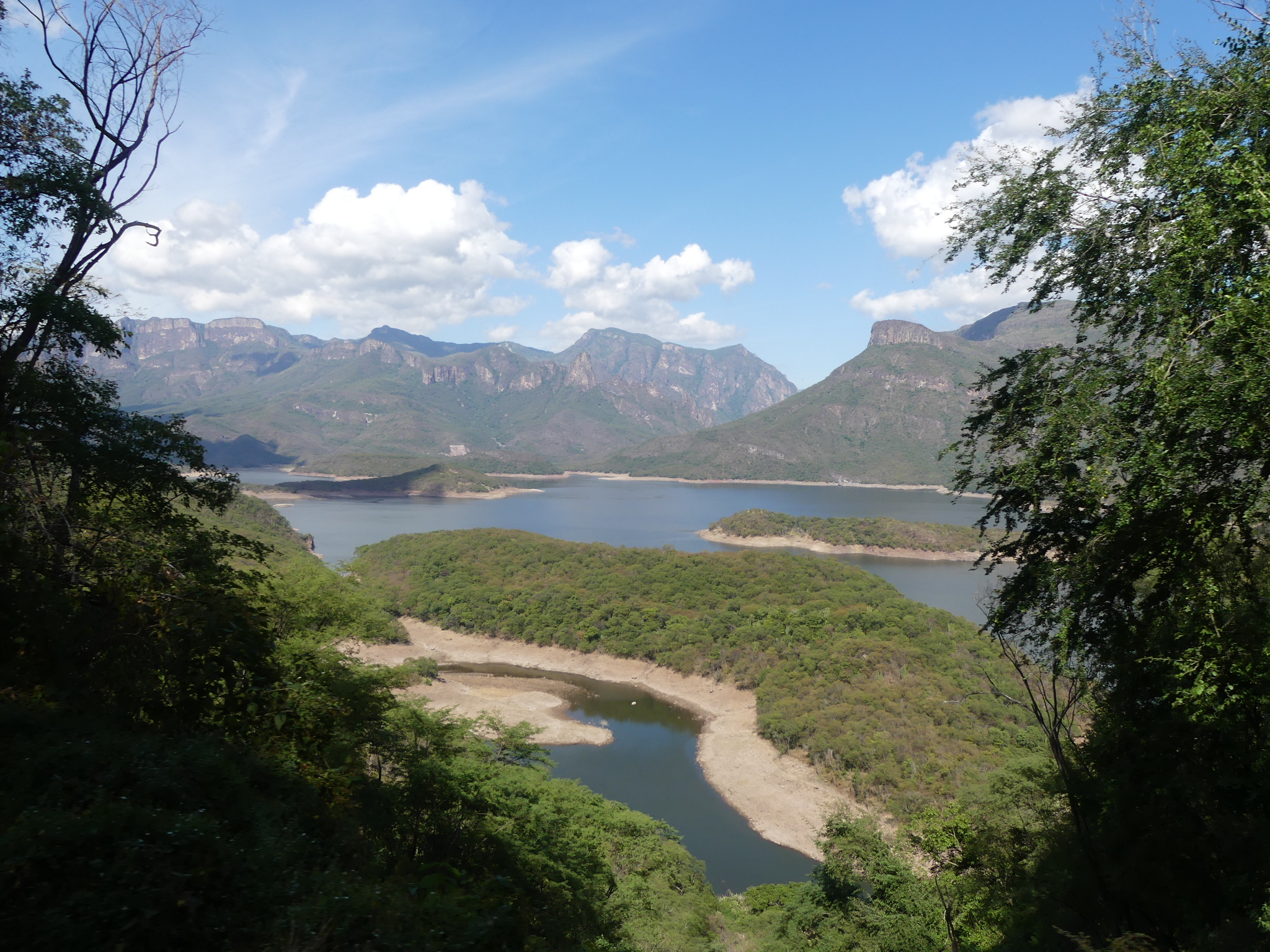
Old-fashioned train travel evokes another time and era with its slower and more leisurely pace. Think “Murder on the Orient Express,” but take away the nasty deed, and sprinkle in spectacular scenery and you’ve got “El Chepe,” the world-famous Chihuahua Pacífico Railroad that traverses through Northern México’s magnificent Copper Canyon, “Barrancas del Cobre.”

The Copper Canyon has been on my Bucket List for several years. It’s not commonly known to most of the world; as the Grand Canyon steals the limelight. We embarked on a 6-day exploration of this fairly untamed, natural phenomenon with our fellow partners-in-crime, Kathleen and John; they, of our culinary excursions to Guadalajara. We couldn’t find a more joyful and adventurous couple to travel with.
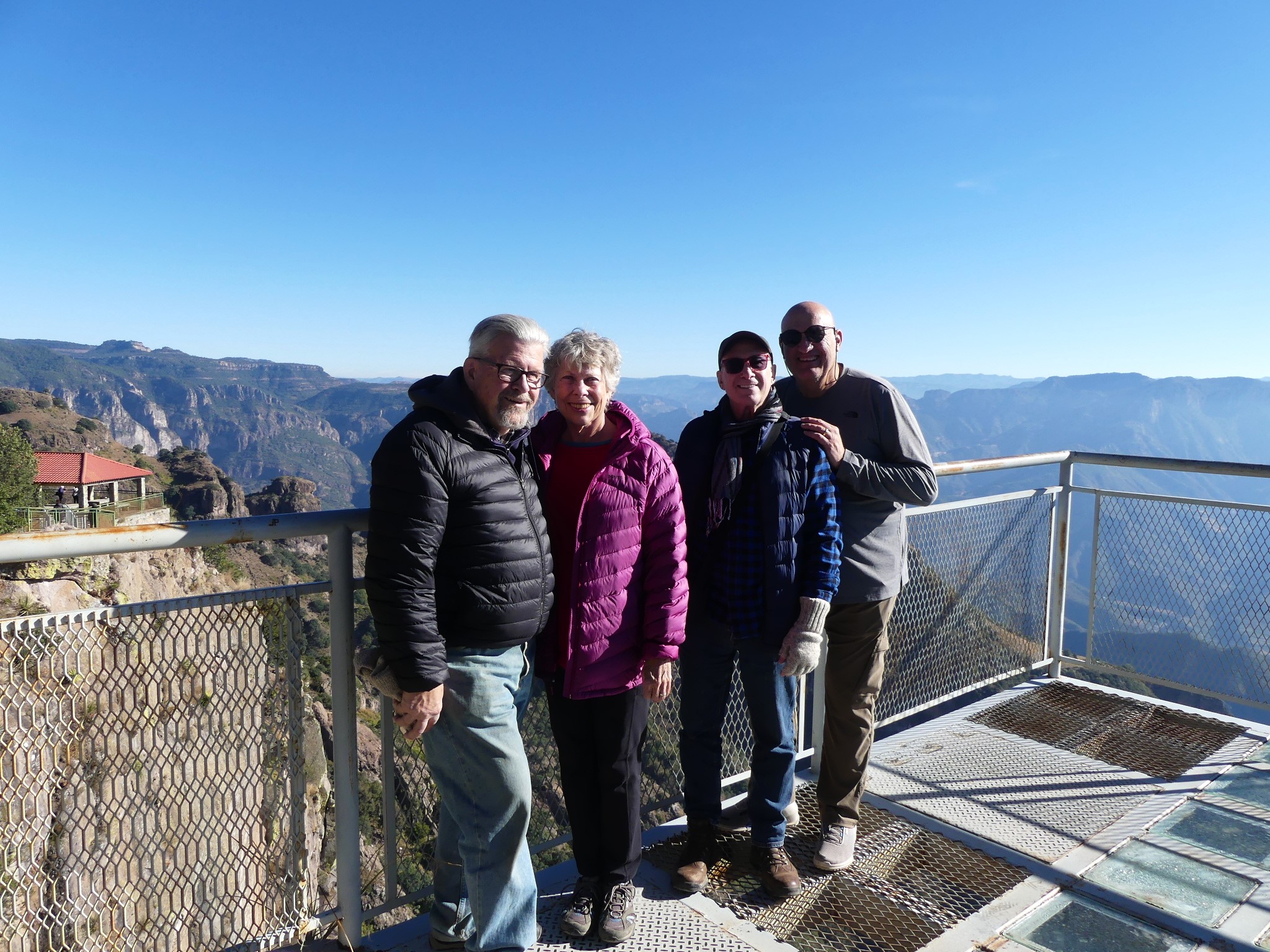
Reader’s Digest has called El Chepe “the most dramatic train ride in the western hemisphere.” We’d ride through some of México’s most breathtaking and spectacular scenery. Words and photos can’t even begin to tell the story, but here goes …
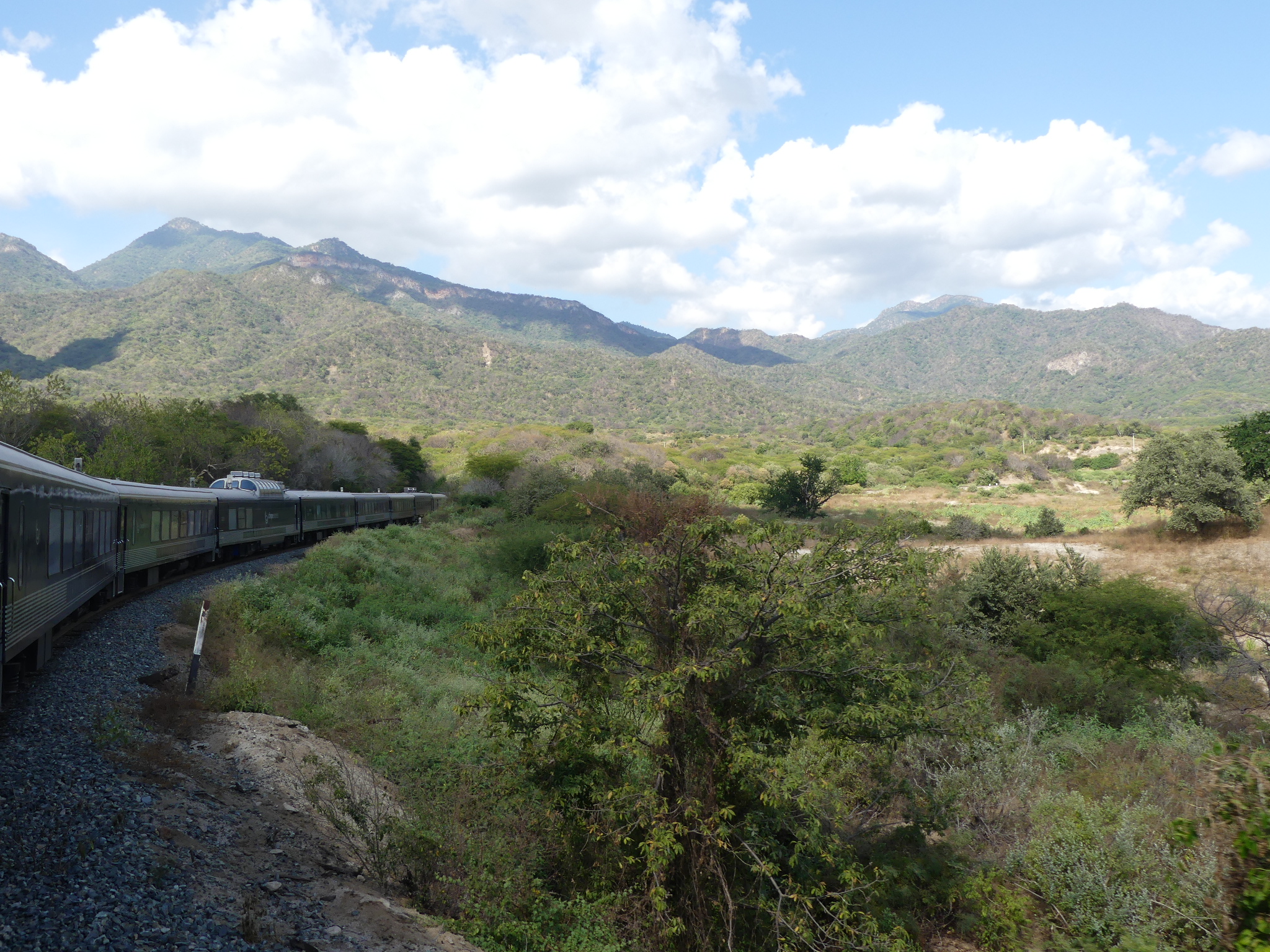
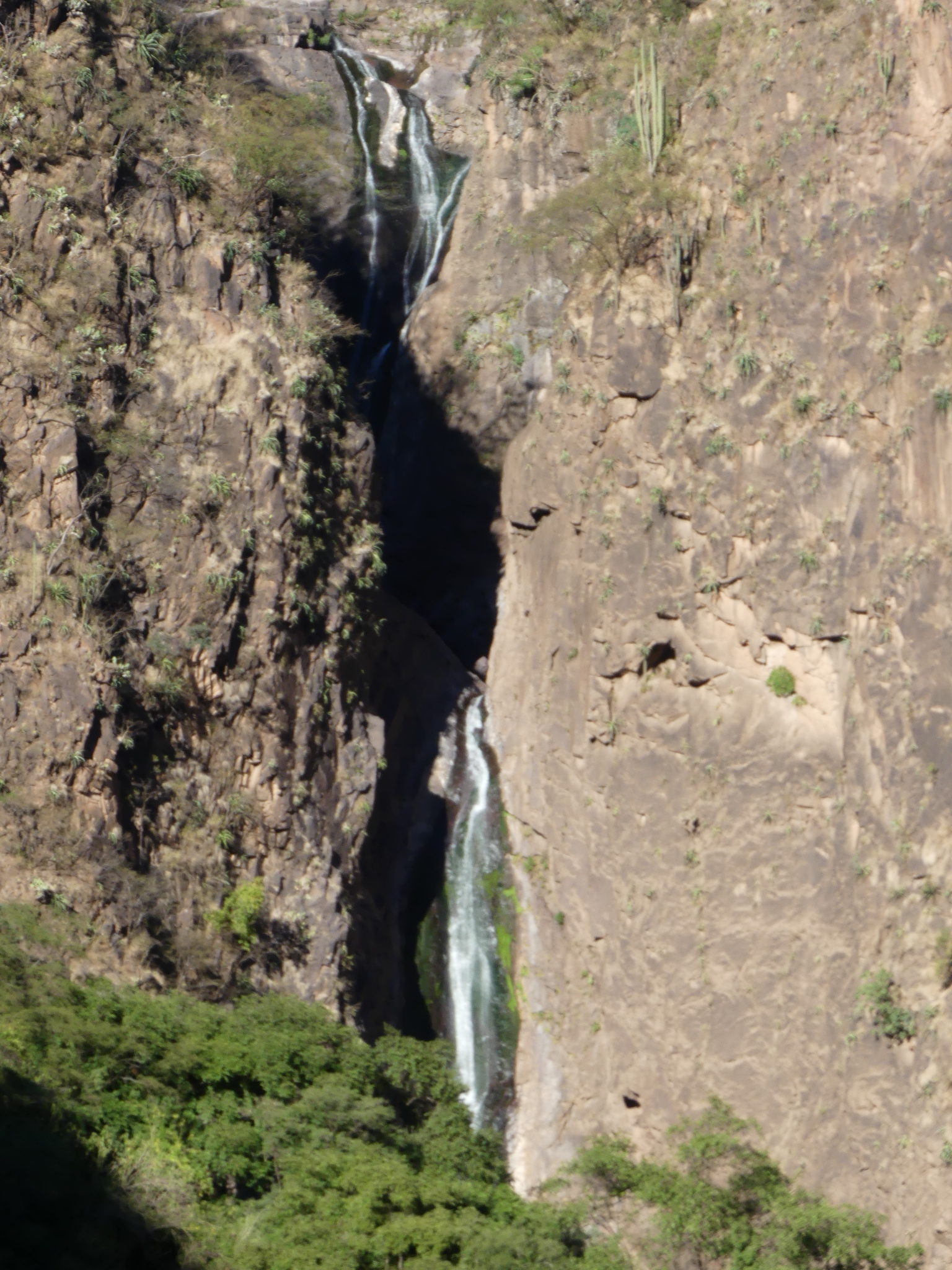
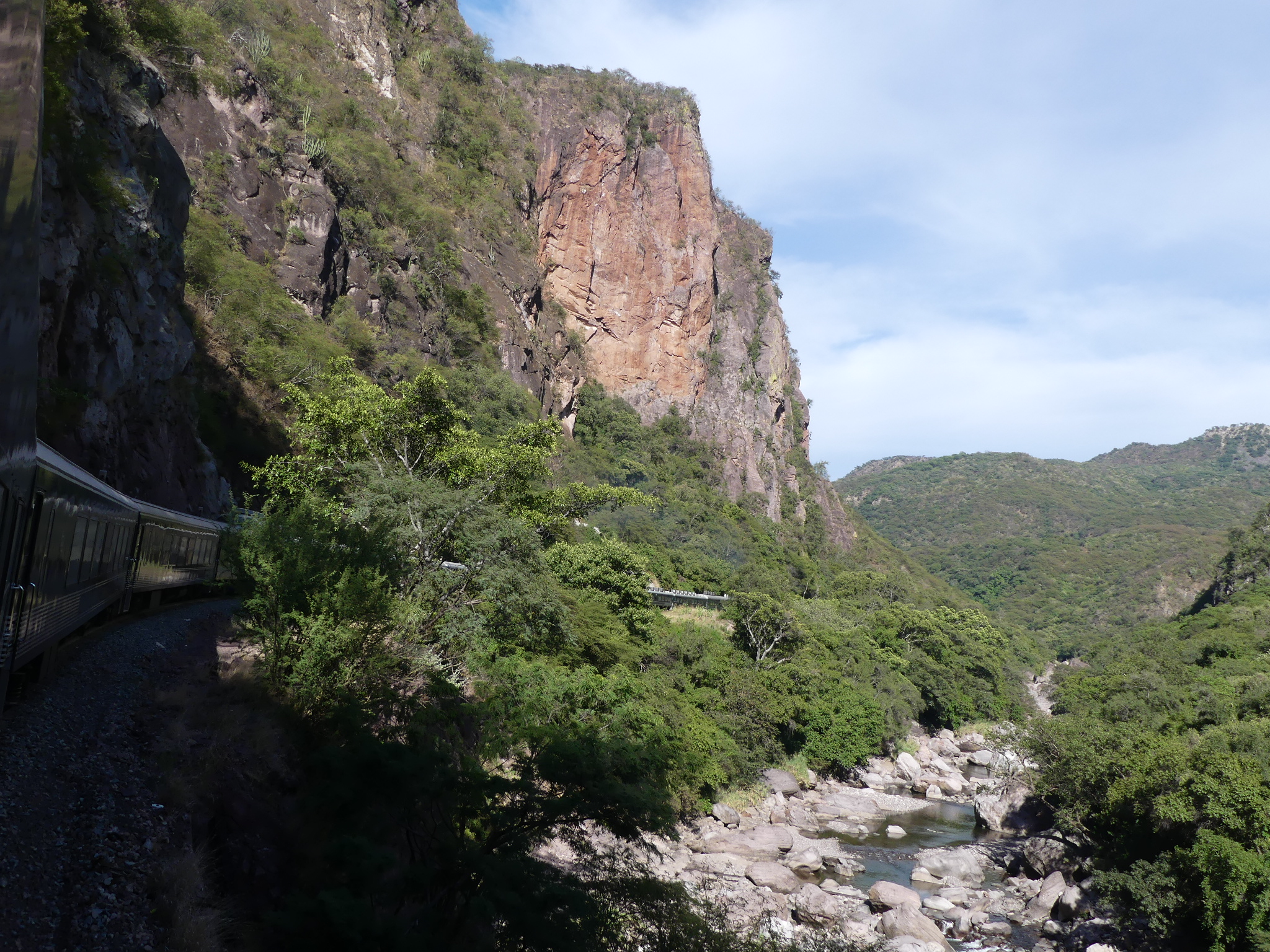
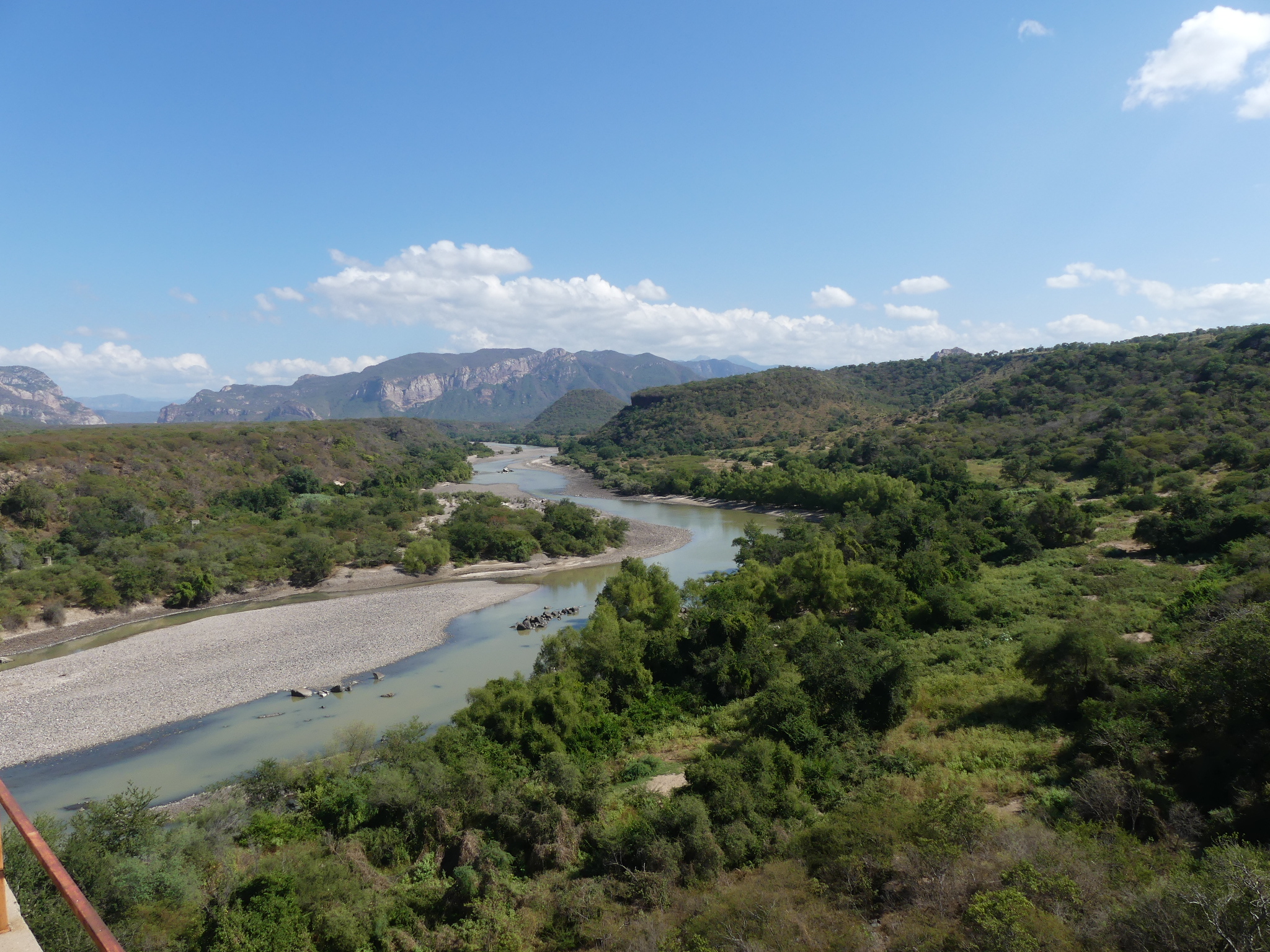

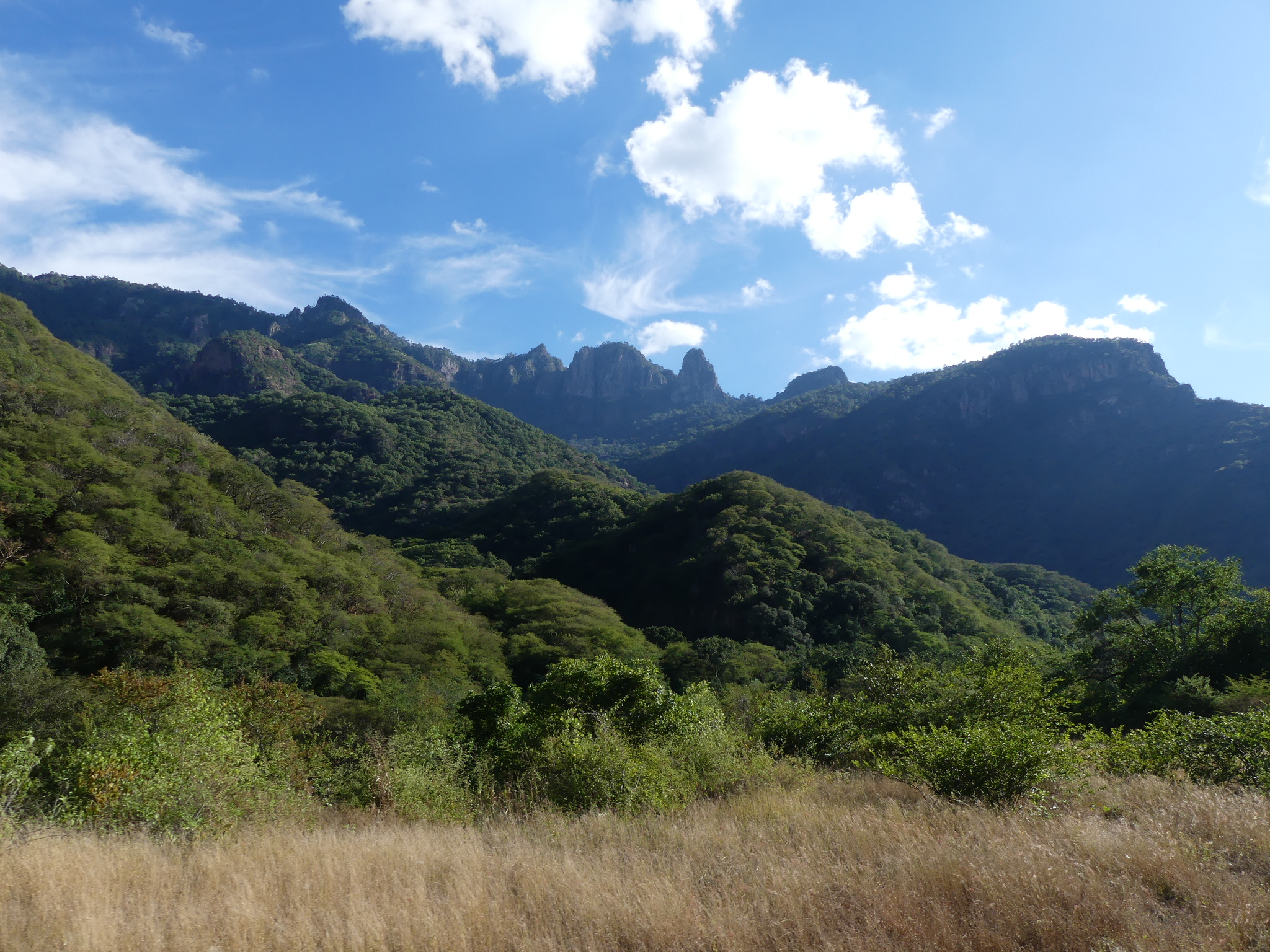
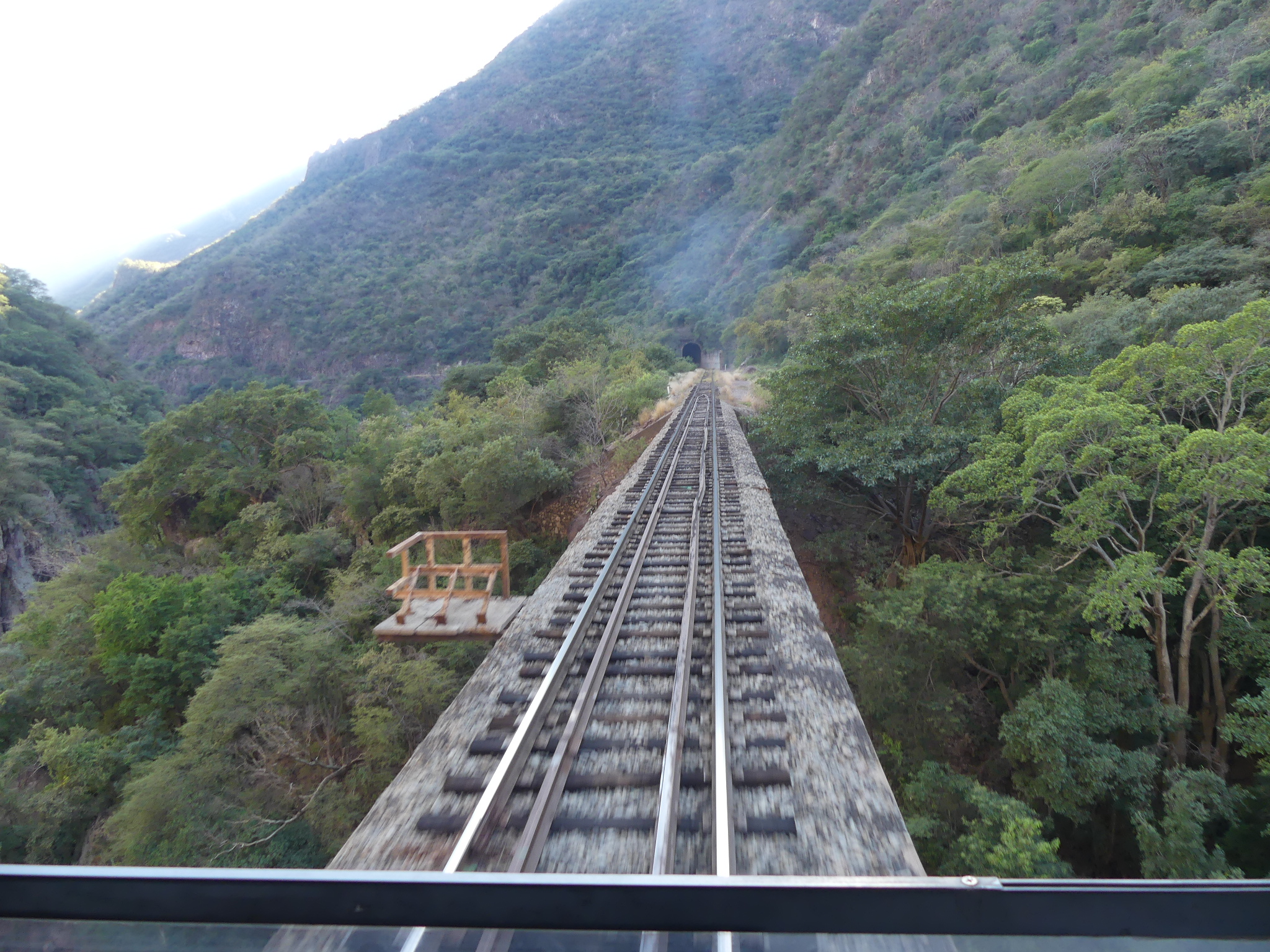
Copper Canyon consists of a group of six distinct canyons in the Sierra Madre Occidental Mountains in Chihuahua State in NW México. The deep Canyons are immense, comprising over 25,000 square miles, and are four times greater than the Grand Canyon (longer, wider, and deeper). Its mighty walls are of a copper/green color, hence, the origin of the name, “del Cobre.”
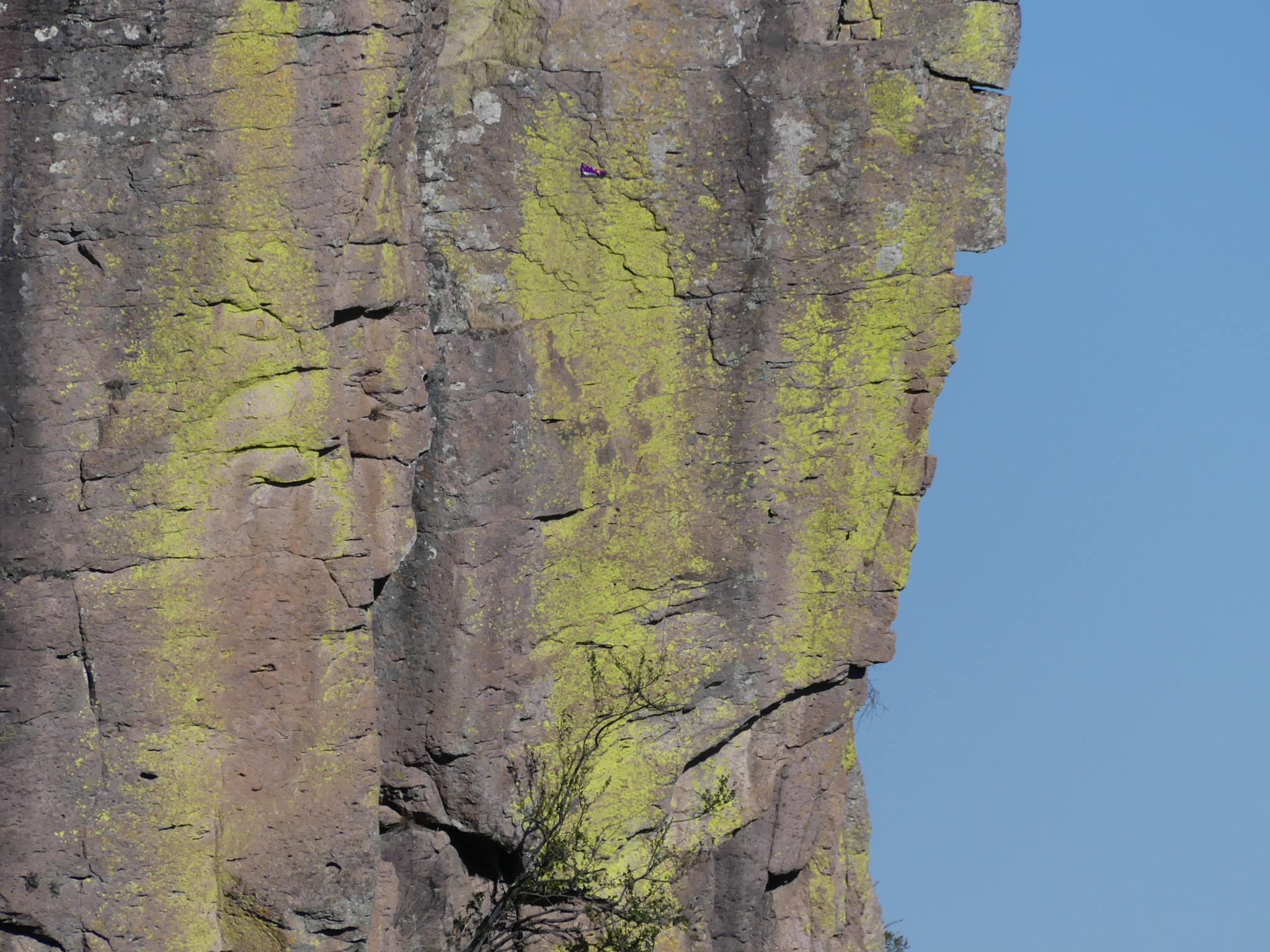
The mountains and canyons are the ancestral home to the Tarahumara indigenous people. They, of the legendary long-distance runners. (See addendum at the end for additional info.)
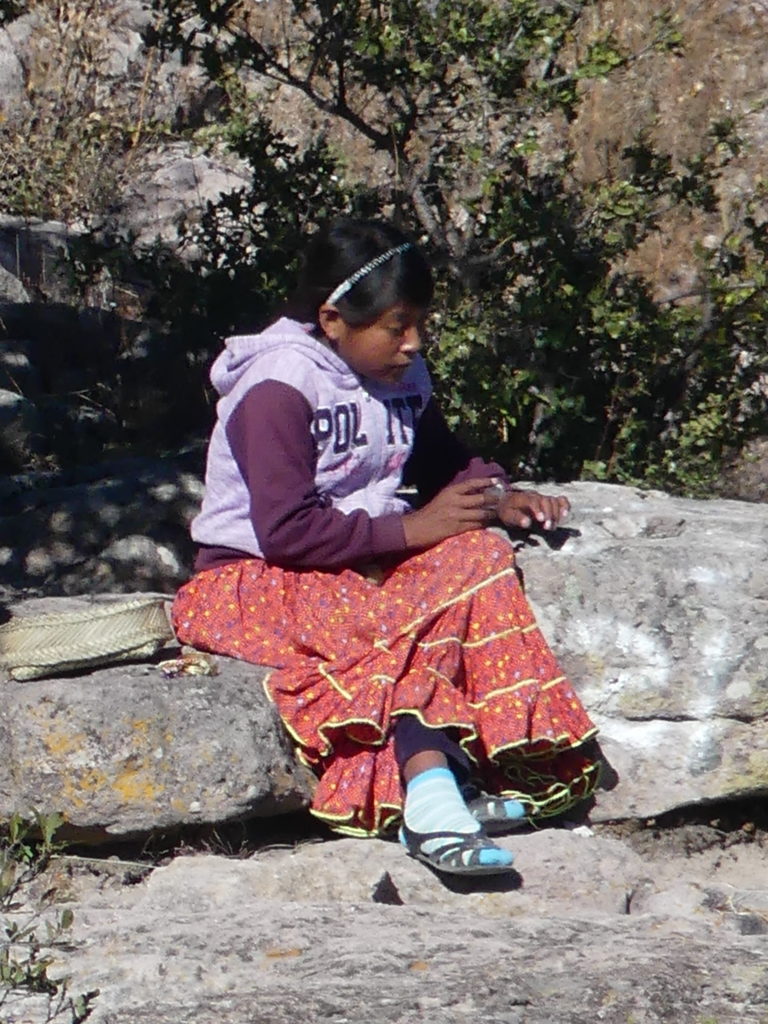
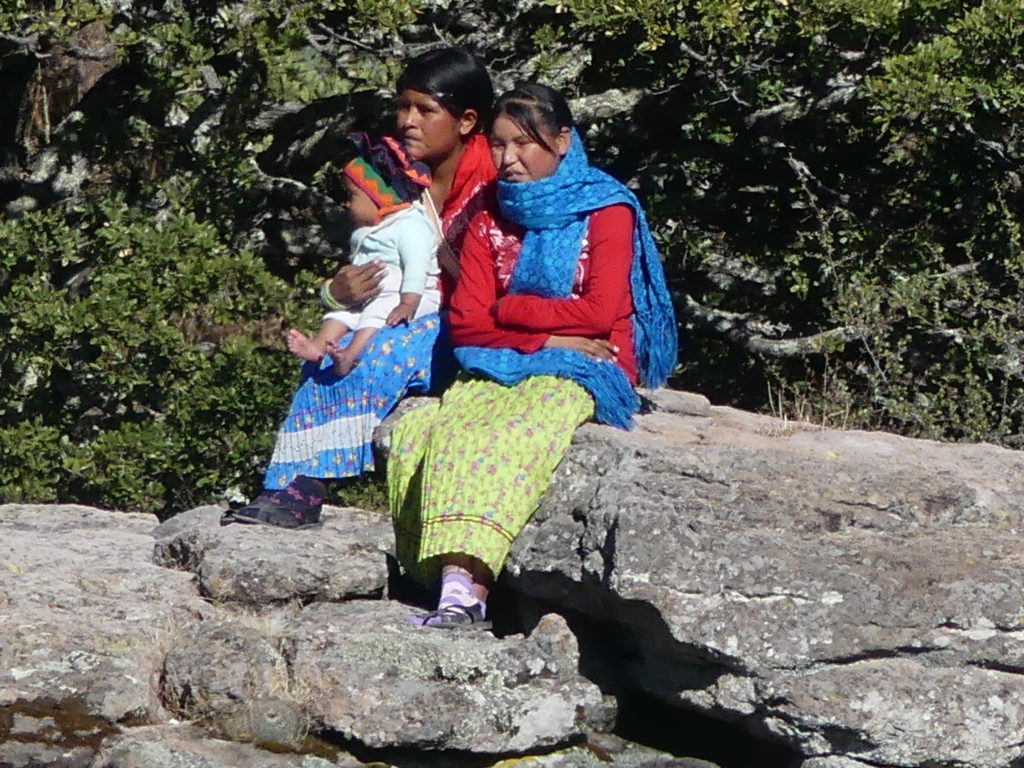
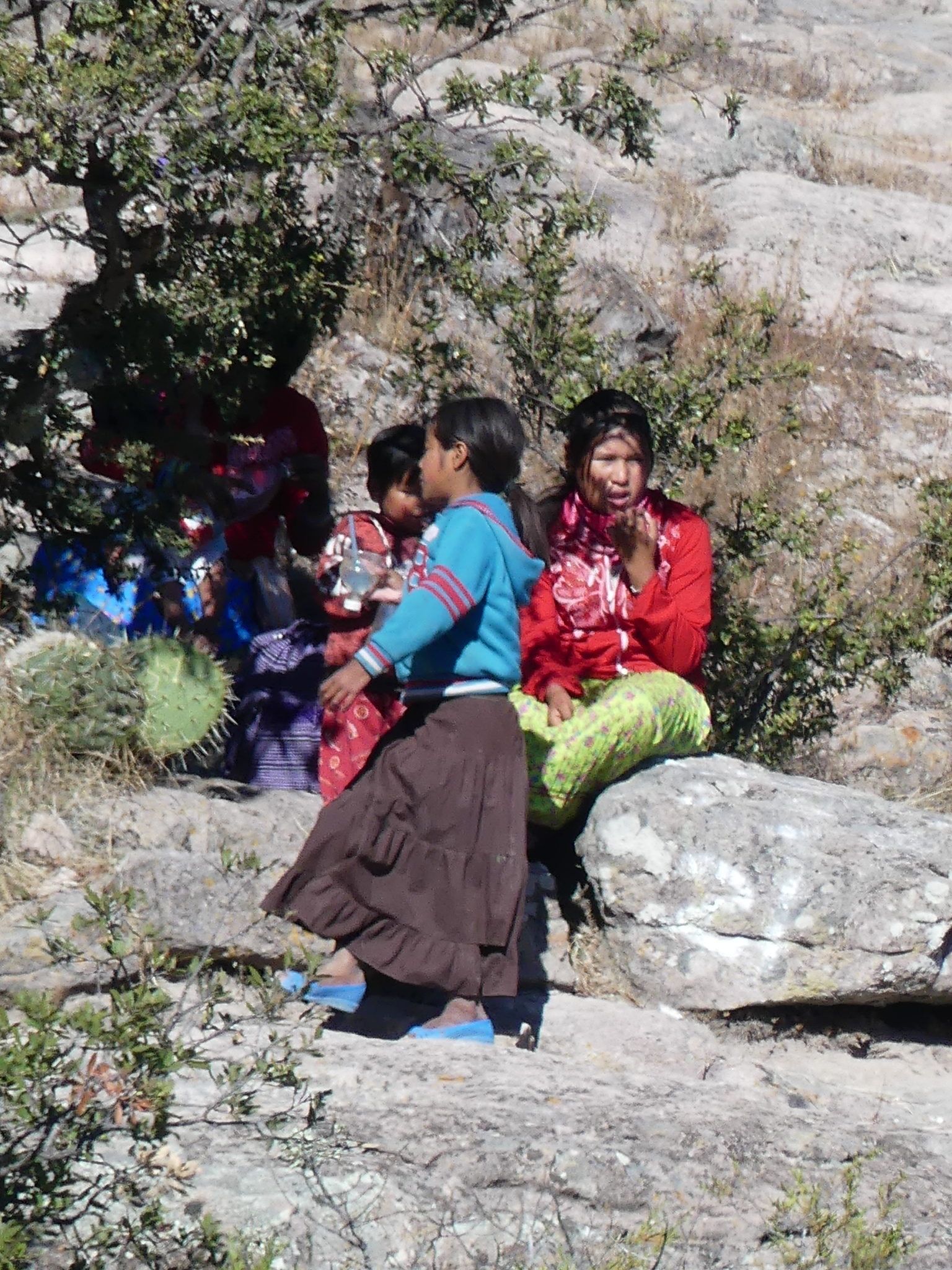
So begins our latest Mexican adventure … in Los Mochis, the city named for the flowers of the Mochi plant, as our starting point in Sinaloa State. It’s the western terminus of El Chepe and a major agricultural center for the surrounding farming region: sugar cane, cotton, rice, flowers and vegetables. We were in the heart of production of Mexico’s tomatoes, bell peppers and cucumbers ~ the land of salsa.

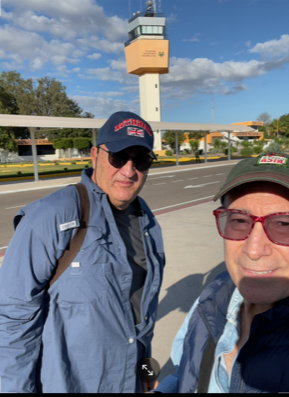

We were met at its small airport by our hotel’s driver, who then took us to El Fuerte, “The Fort,” an hour north, where our train ride would begin the following morning. The colorful colonial city is known as the Gateway to the Copper Canyon, and is another lovely Pueblo Mágico of México to add to our growing list of Magic Towns.








Along the way, an unscheduled, but important food stop was made with our driver’s suggestion, to the roadside bakery stands, “Pan de Mujeres,” (Women’s Bread). They’re found along El Crucero at Santa María (train crossing) on the outskirts of this small pueblo. The wide variety of its sweet breads are a famous Sinaloa specialty. This was a fortuitous, unexpected treat.
The breads are made of soft, semisweet flours of whole wheat, and are stuffed with a variety of delicious, local ingredients: pumpkin, piloncillo (Mexican brown sugar), cream cheese, rajas (roasted poblano pepper strips). They also bake small, crispy empanadas that are filled with: cajeta (caramel), blueberries, or blackberries. After much munching in the car, I’d wished that I’d bought more than one box. They were that yummy.





As we’re devouring our sweet breads, our driver turns to me and asks (en Español) if I knew why they were called pan de mujeres. “No,” I innocently replied. His giggly response, “Es porque no tienen huevos.” I almost choked on my empanada from laughing so hard. My traveling companions were asking what’s so funny. I told them, “It loses a lot in translation.”
We checked into The Hotel Posada del Hidalgo, a beautifully restored colonial mansion, and now boutique hotel in El Fuerte. It originally was the sprawling hacienda of a former town mayor. An adjacent, now attached building is the supposed birthplace of the character, Don Diego de La Vega, aka “El Zorro.”




The hotel has multiple, beautiful courtyards full of tropical vegetation and fountains. Steps away was the town’s beautiful central plaza, where we hung out and leisurely enjoyed coffees, and watched the plaza slowly turn itself into a festive town fair in the upcoming days.
Back at the hotel, David and I shared a midafternoon snack of Guacamole and a local delicacy, Callos de Corbina (fish ceviche, where the cut of fish is made to resemble scallops). The dish ranks up there with one of the best ceviche’s ever tasted; my taste buds dancing an Umami Cha-Cha.



During our dinner in the colorful, paper flower bedecked dining room, a hokey El Zorro show was in progress poolside. We could hear Zorro, but found the character’s voice didn’t match what you’d expect to hear – that of a strong, macho man. It made for a distorted and distracting image of the famous and dashing masked avenger.
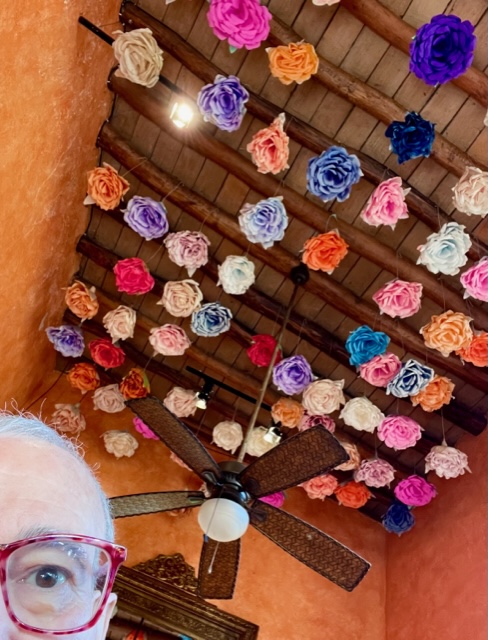

EL CHEPE
Bright and early the following morning, we were directed to the far end of the train platform, where our carriage would be. There we stood, anxiously awaiting El Chepe, along with many other eager riders, for the start of a 5-hour day’s journey through the Sierra Madre Mountains (it grew into 7-hours because of a stalled cargo train ahead of us as our conductor explained).
The train suddenly appeared from around the bend and it surprised me how long it was. It pulled into the station with such a commanding, powerful presence. The El Fuerte train station, was at 600 ft above sea level, but we’d ascend to over 7,000 ft. at our final disembarkation later in the day.
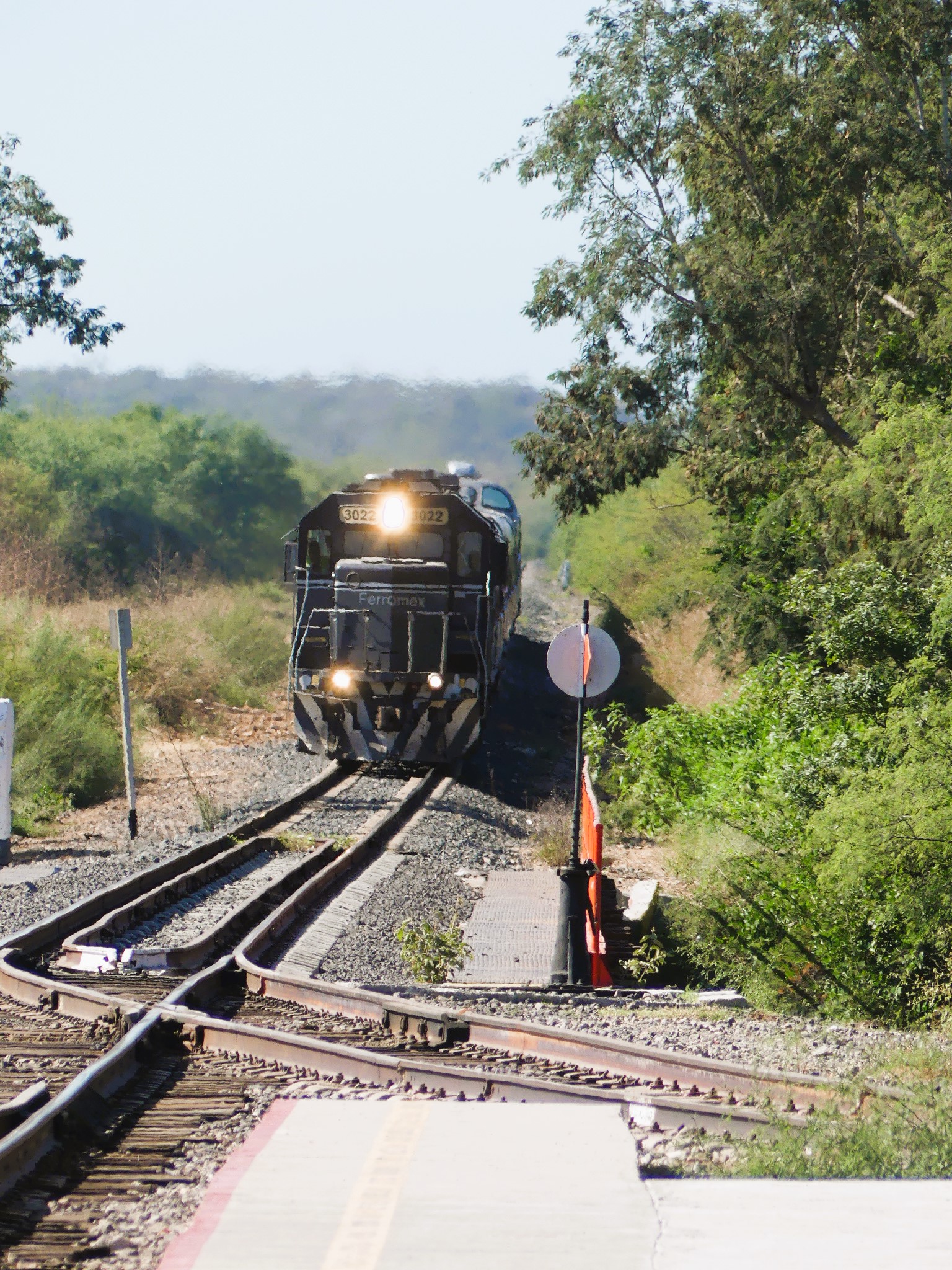

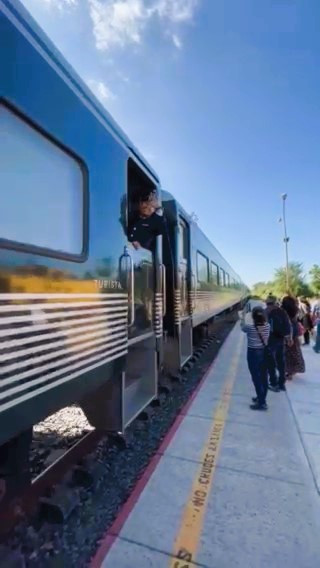
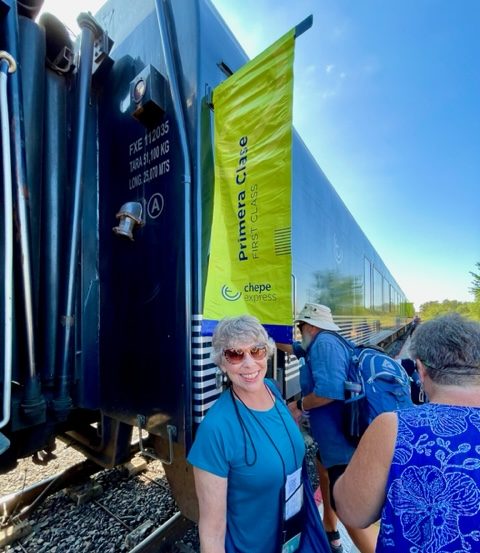
The railroad is an engineering masterpiece that took about 90 years to complete and 90 million dollars. The plans included 87 tunnels (the longest measures 1.15 miles), and 39 bridges lining the route. Two of the most notables are the Chinipas Bridge at 765 feet long, and 335 feet high, highest on the line. The Aguascalientes Bridge, crosses the El Fuerte River, and is 150 feet high and is the longest bridge on the route.
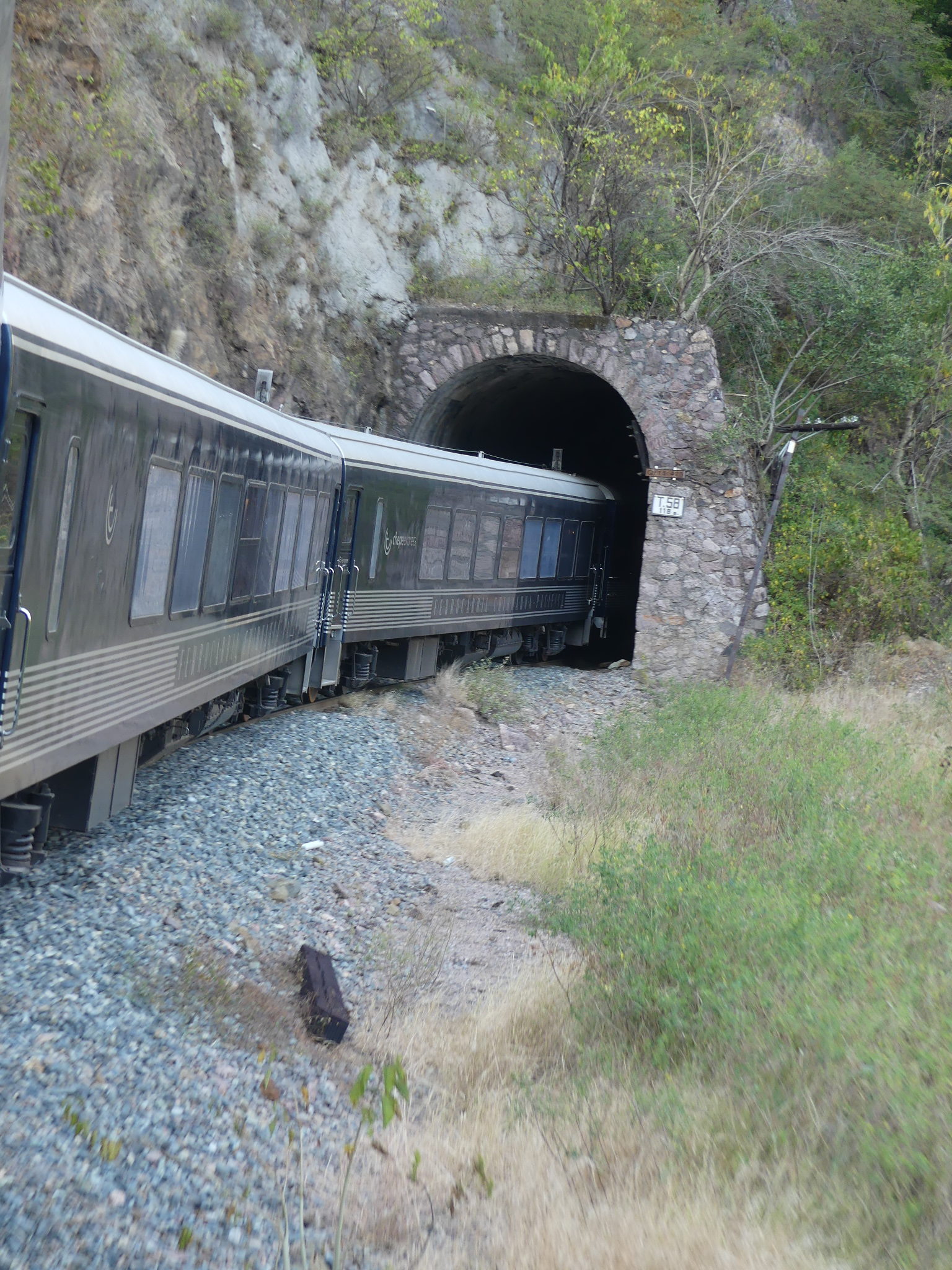

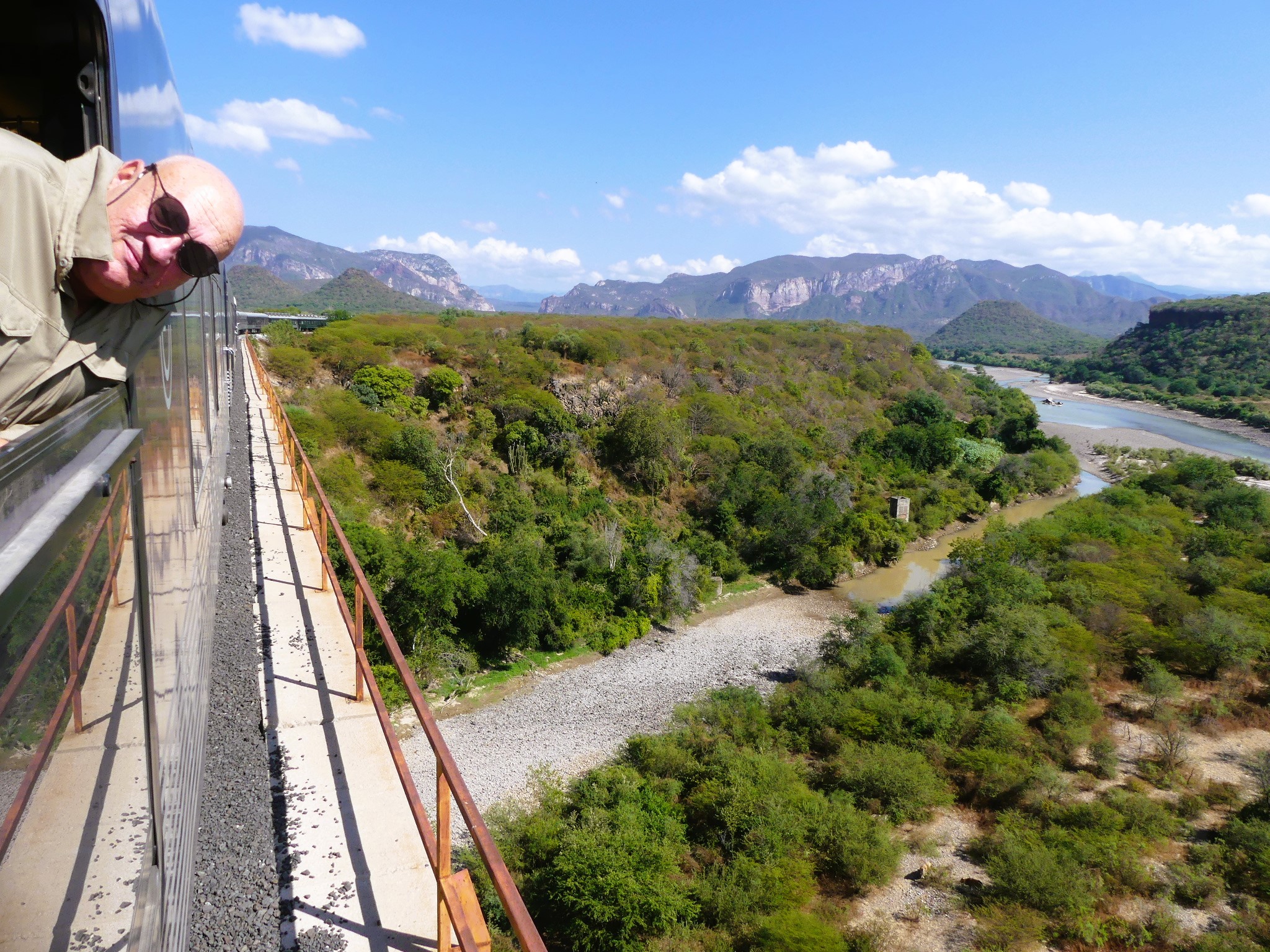
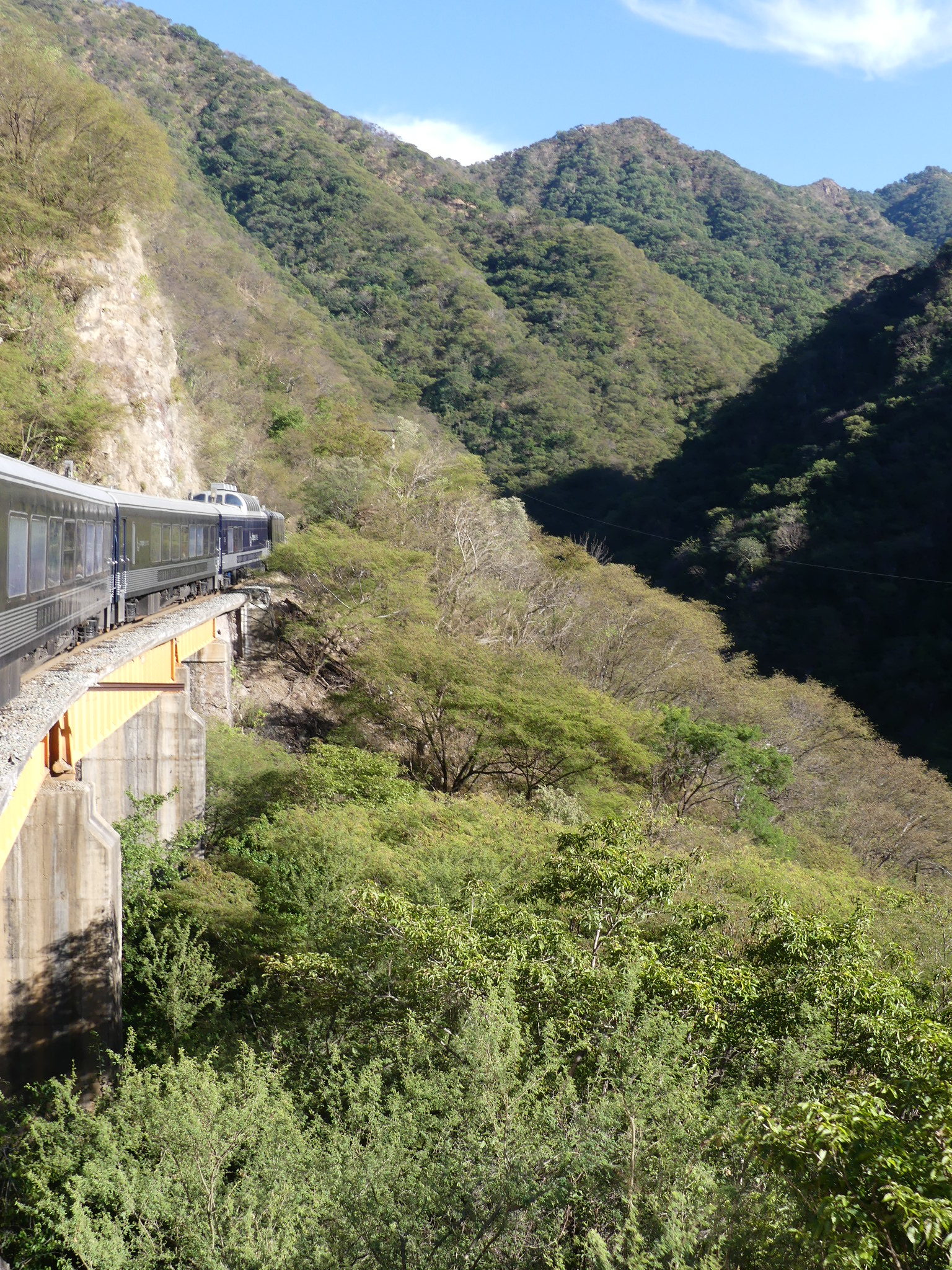
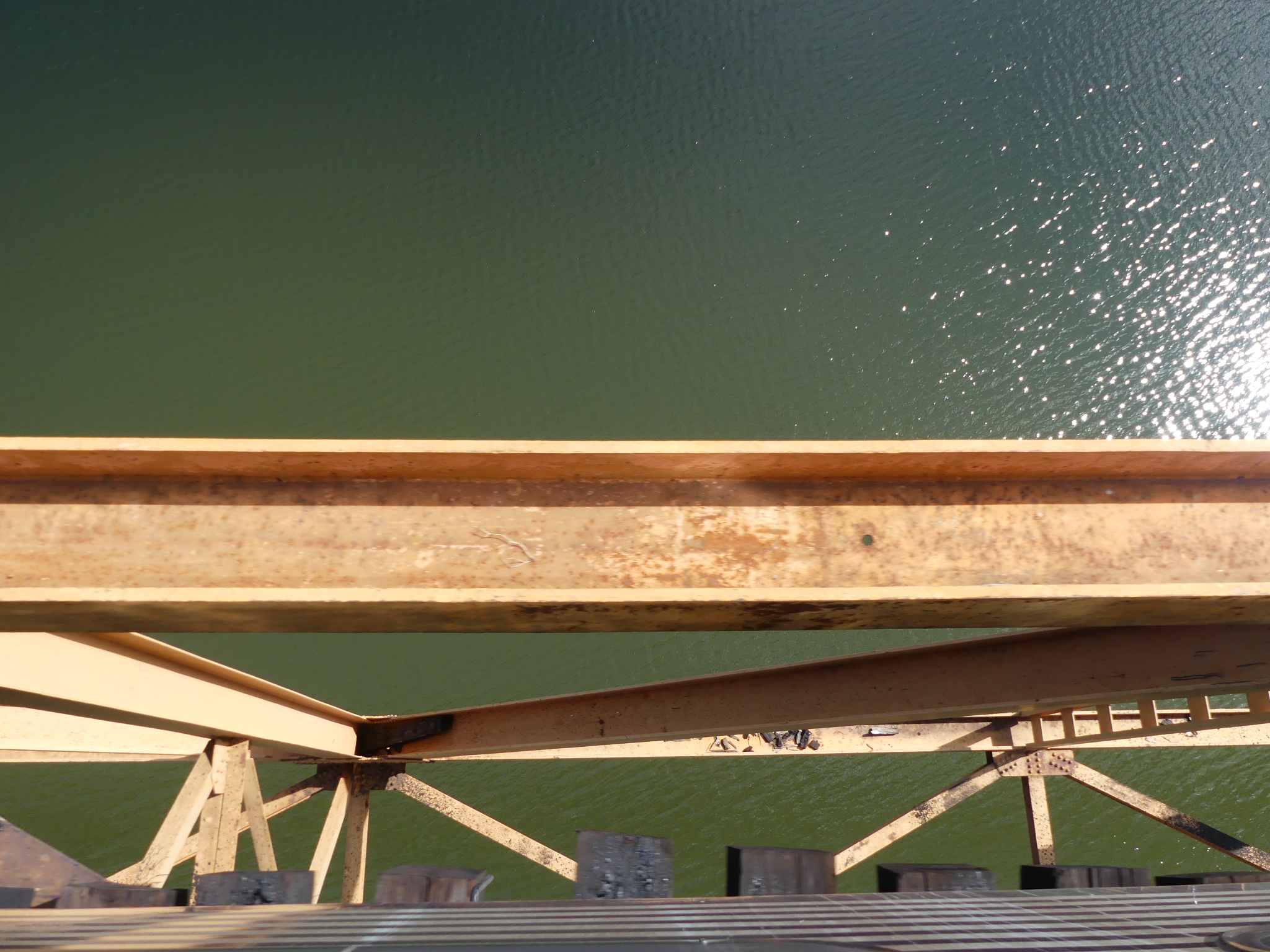
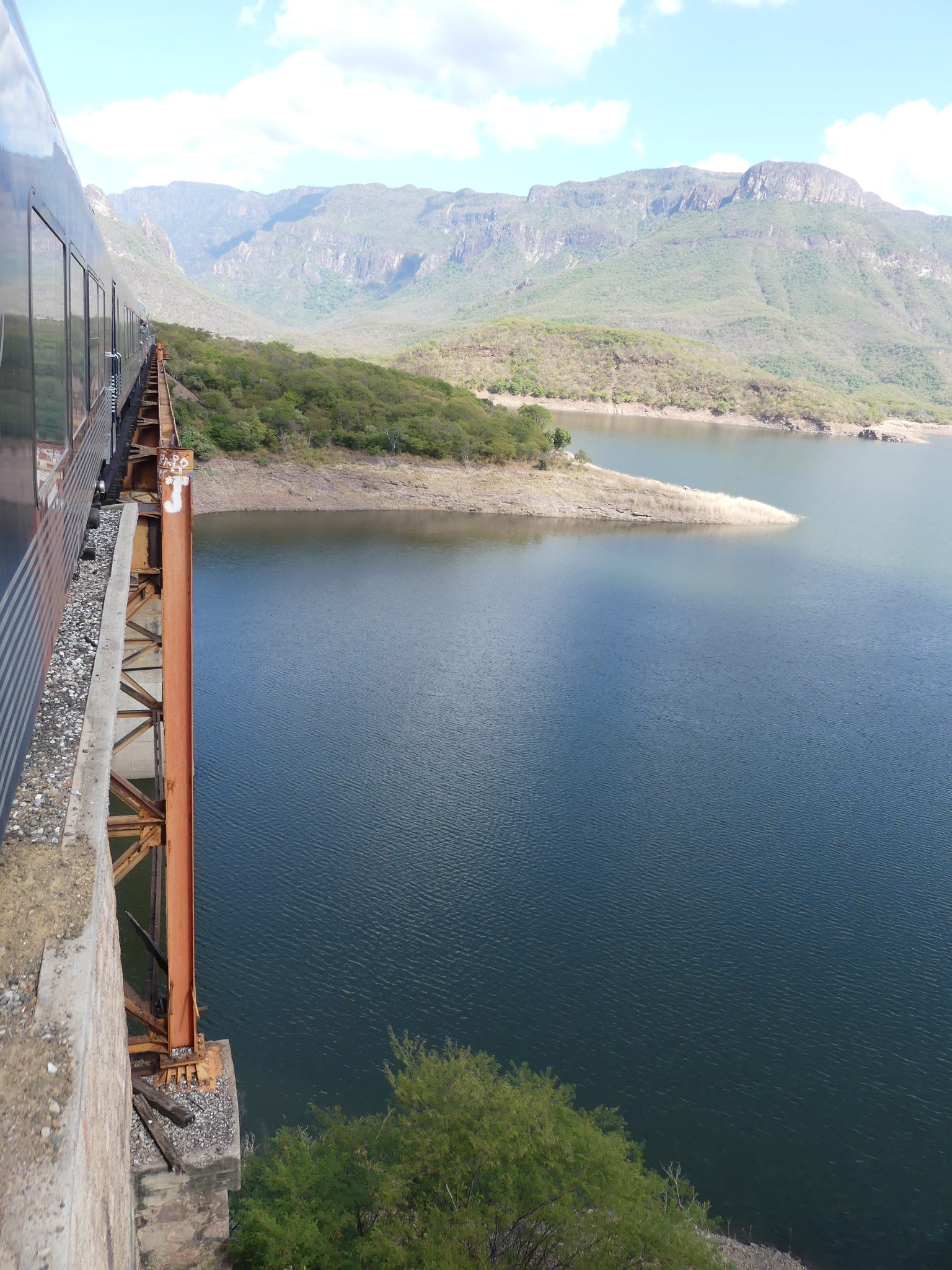

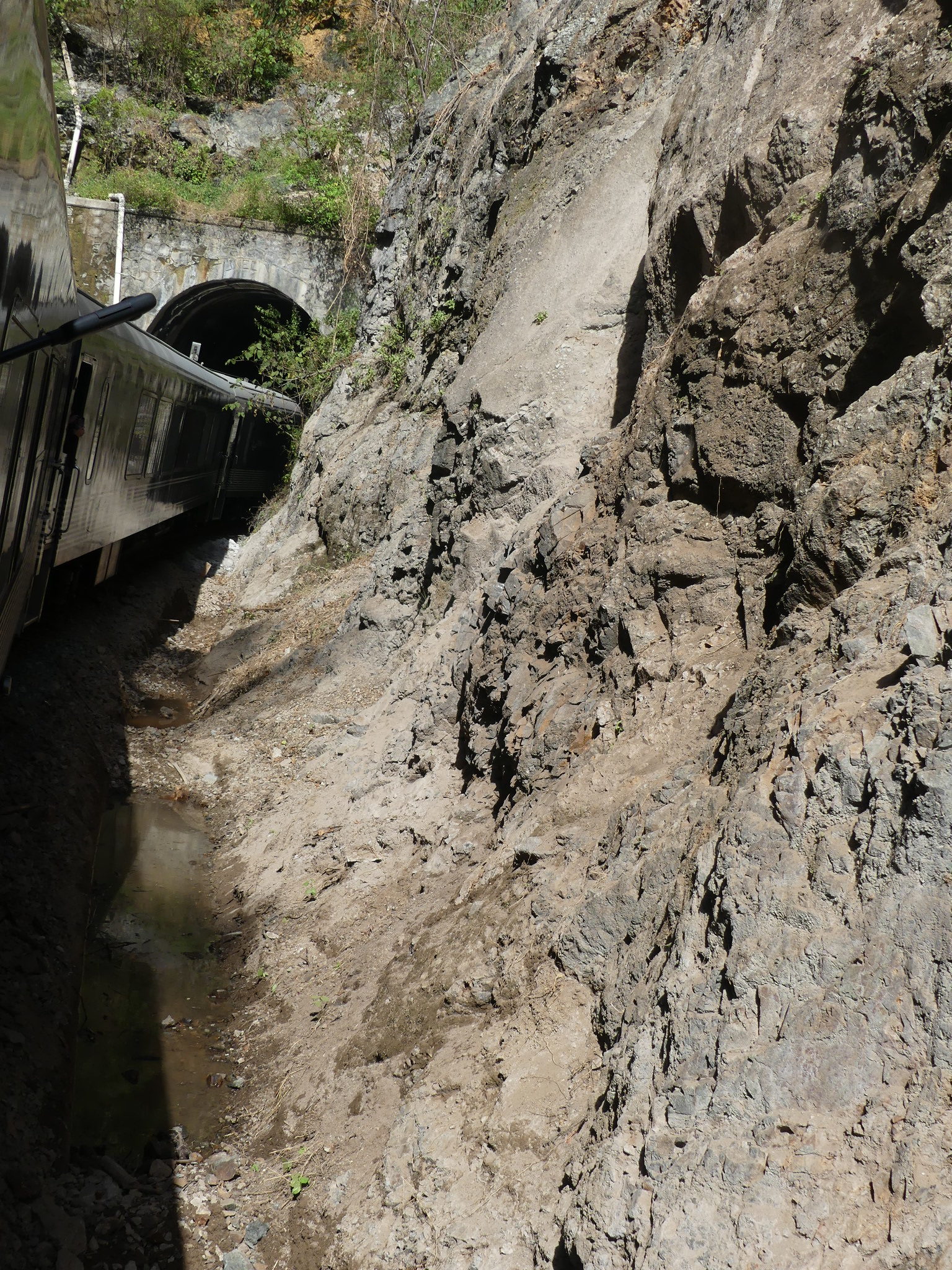
Once seated, and the conductor had checked our tickets, my travel companions rushed back to find a place in the last car, aka the bar car. Half of the carriage is enclosed with big, wide view windows; the other has windows open to the elements and the extraordinary panoramas. Here’s where David perched himself for hours, camera in hand, marveling at the scenery, and happily snapping away …




The bar car was filled with young Mexicans drinking, singing, laughing and cavorting loudly, muffling the rhythmic sound of the wheels of the train. Train travel slows us down and provides a momentary escape from the crazy world outside. This party group was reveling and taking full advantage of the slower pace.
One thing I’ve noticed in our travels throughout México is how much national tourism is happening. Mexicans love their country, and as we’re gradually discovering these past four years, there’s so much to see within its 32 states (we’re just over half-way there).
Lunchtime and a very forgetful meal was served in the dining car. The only saving grace was the dessert flan smothered in a cajeta sauce. I’m very much stealing that idea when making my flan. The caramel coating adds the perfect touch.

The most awe inspiring work of engineering is when you see the front of the train going in the opposite direction from you. Let me try to explain this incredible feat … This amazing event occurs at a spot called El Lazo (a loop or lasso). It’s most easily witnessed in the last carriage, where we stood and gaped as we watched the train criss-cross, and then climb the steep mountain slope. At a major curve, the train doubles back on itself, first crossing a bridge, then passing under it through a tunnel. Again, it’s a masterful stroke of genius and brought everybody’s heads out the open windows.
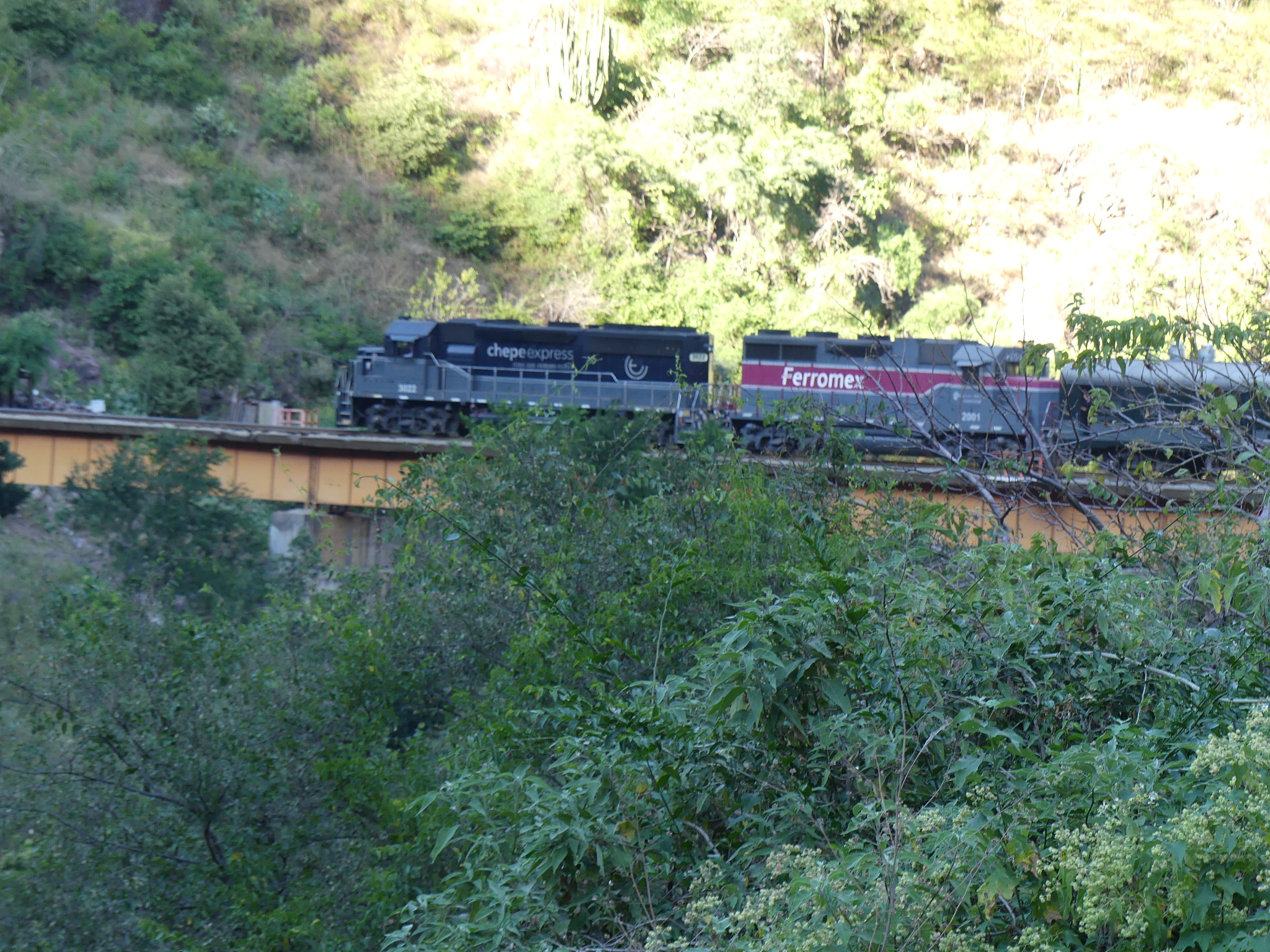
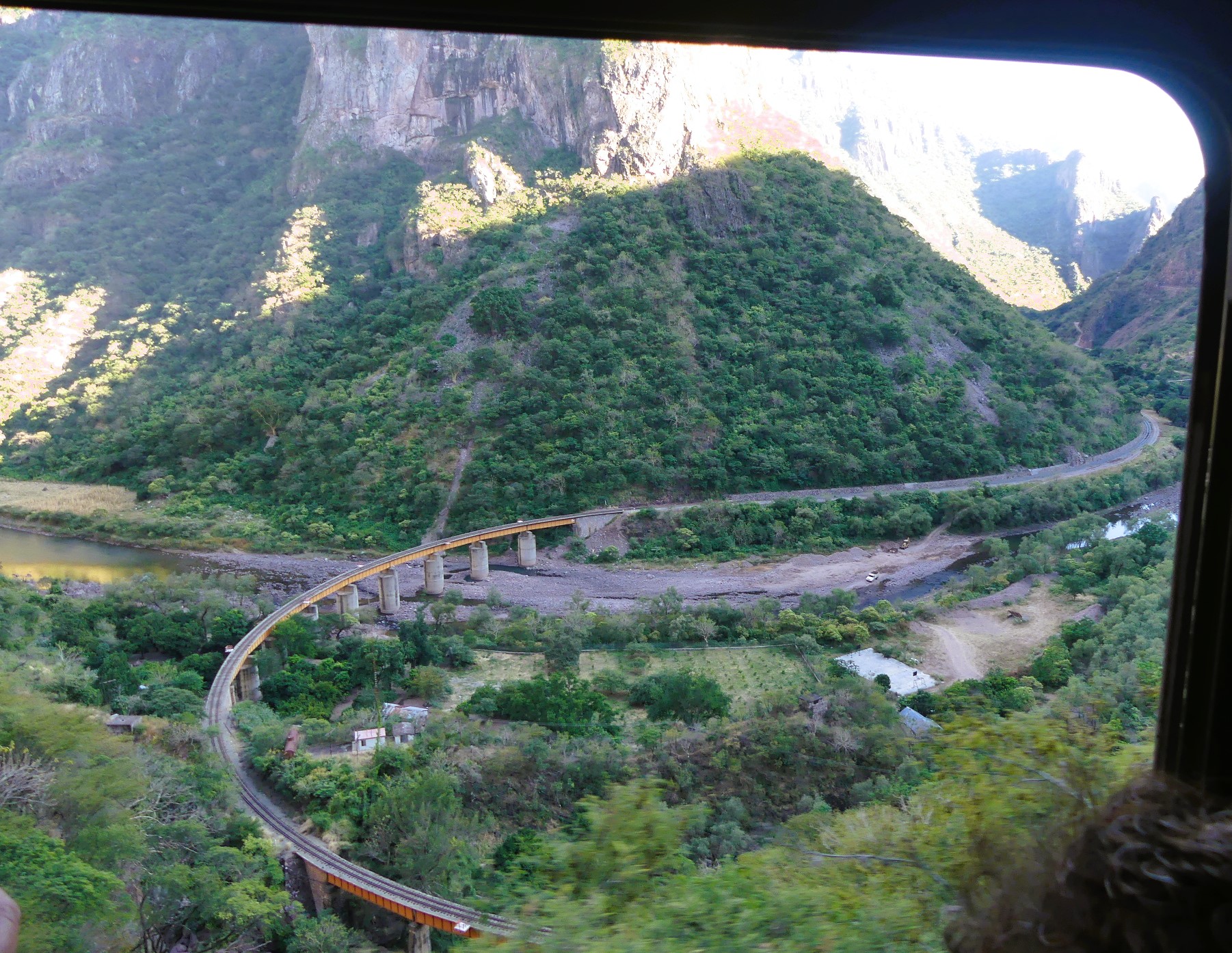
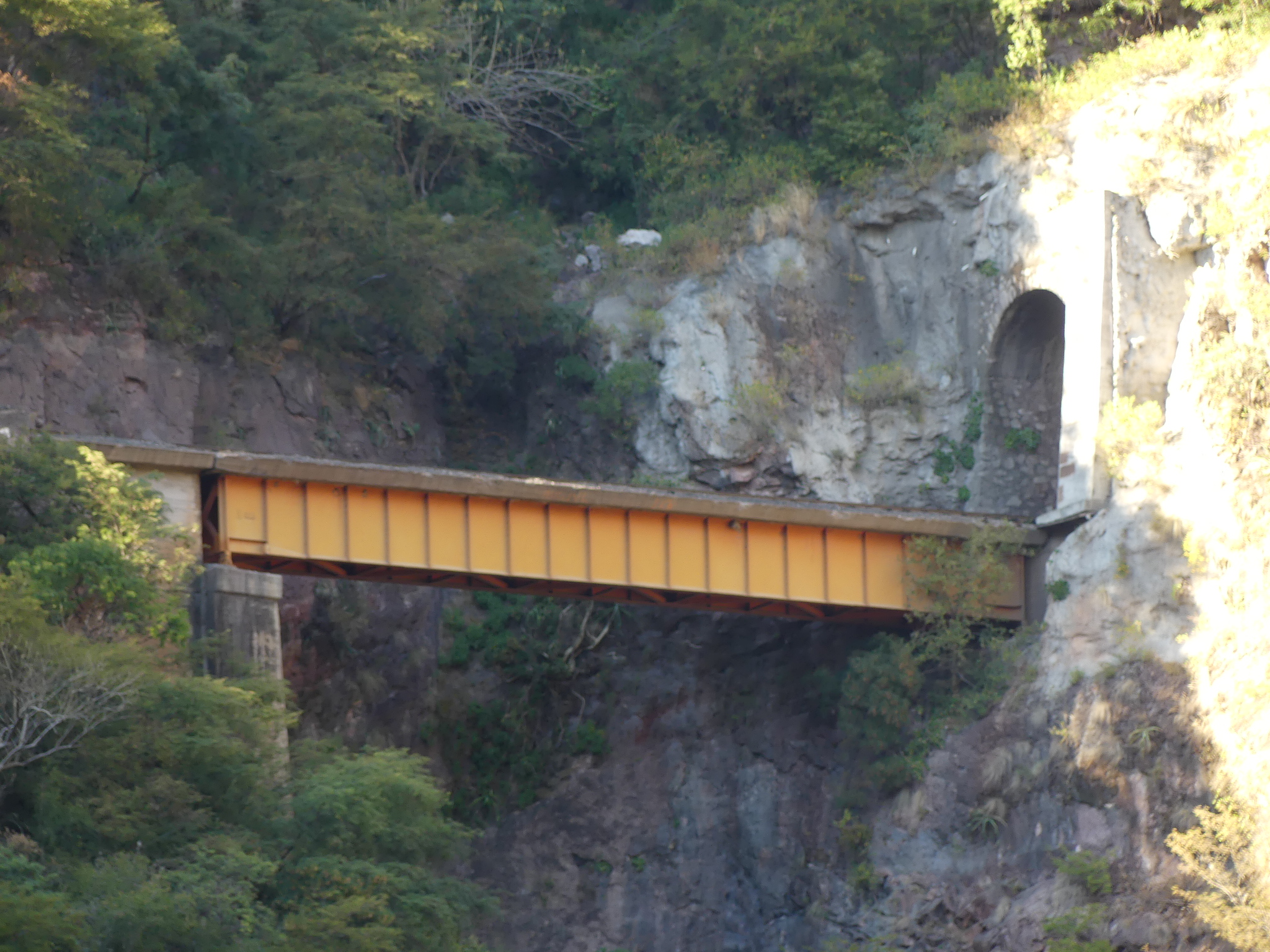
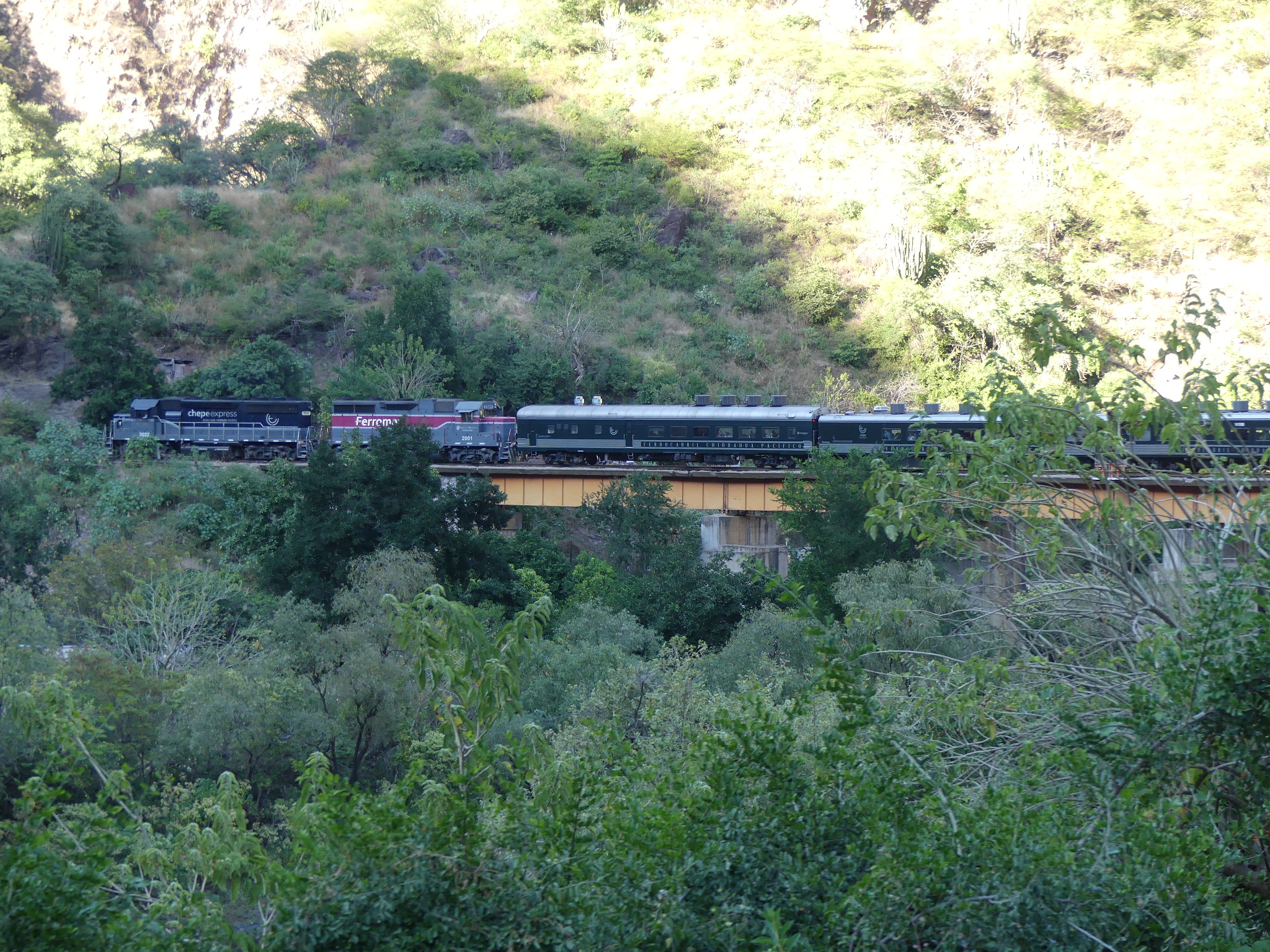
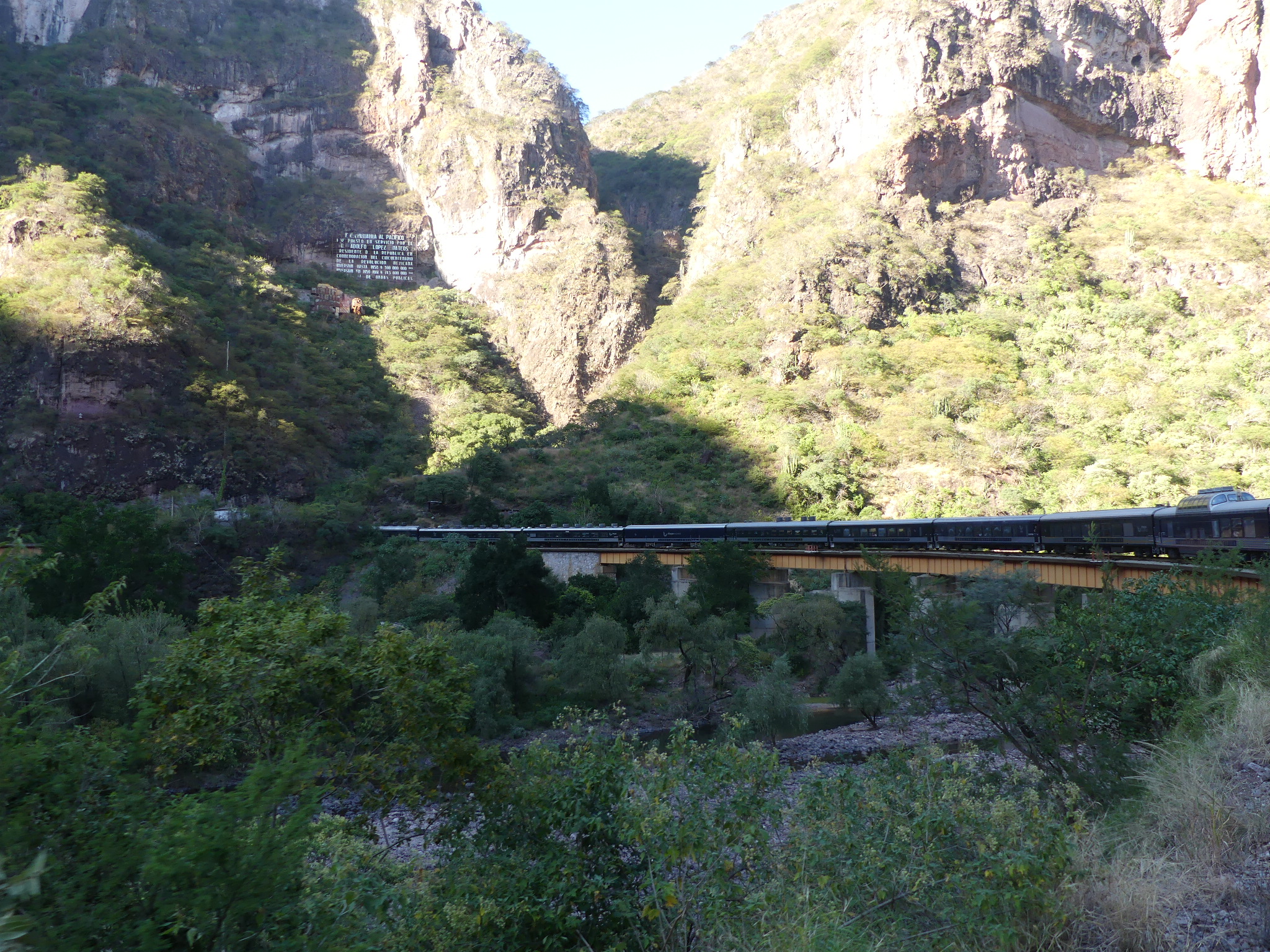
COPPER CANYON
El Chepe was everything and more, but alas, it was the end-of-the-line for us. A day’s train adventure was ending, but more thrills lie ahead of us.
And so began our land portion in the beautiful valley of Cerocahui, and two days at the picturesque Hotel Misión in the small pueblo of the same name (founded 1680). David had read in the itinerary that right next door to the hotel was the Tewecado Mission School, so he schlepped a heavy tote filled with school supplies. The hotel arranged for us to meet the Mother Superior, and present her with them and a financial donation.






The school was established to provide young Tarahumara girls with food, shelter, clothing, medicines, and most importantly, the education necessary to ensure a productive future. Five sisters from the founding order, and nine secular teachers provide classroom instruction for almost 250 day students, and a home for 80 Tarahumara girls up to age 12.
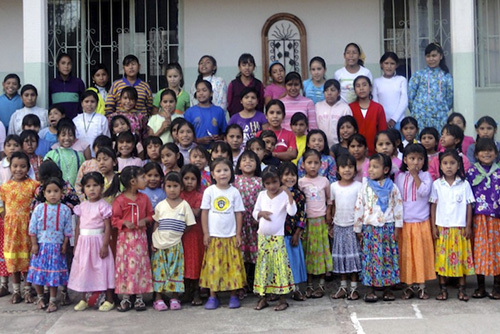

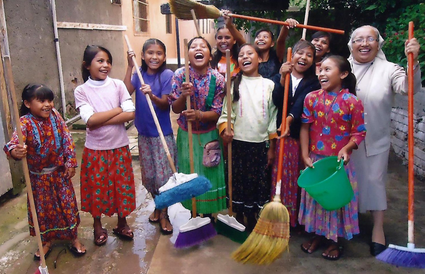
In addition to the regular classroom curriculum, the girls are instructed in personal hygiene and cleanliness, as well as Tarahumara culture, traditions and language. The school is very proud of its two Tarahumara girls currently attending university in Chihuahua.
That evening we sat outside our hotel, and waved to the shy girls in their bright colorful dresses as they walked single-file to attend mass at the 16th-century church just across the narrow street. I happily followed along and attended, basking in their angelic voices as they sang along to the day’s service.




Happily for David, the Hotel Misión has an old vineyard on site and sponsors wine tastings of their bottlings. The five wines produced here were of excellent quality, and we ended up purchasing a case of three types: two red blends and their lovely Rosé, El Vino de Mi Madre (My Mother’s Wine) with its own “lucky charm” attached – a handcrafted wooden doll keepsake.

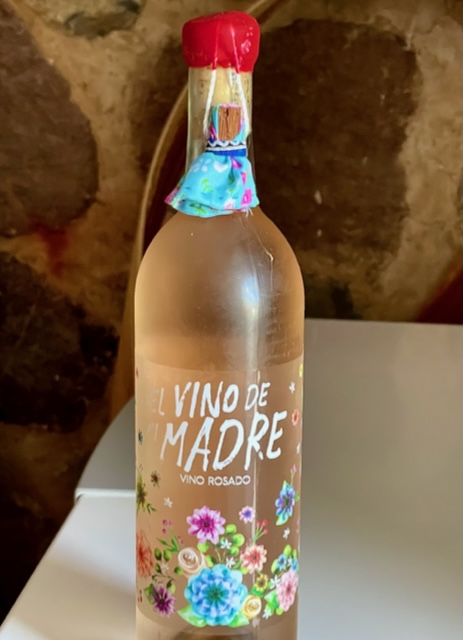
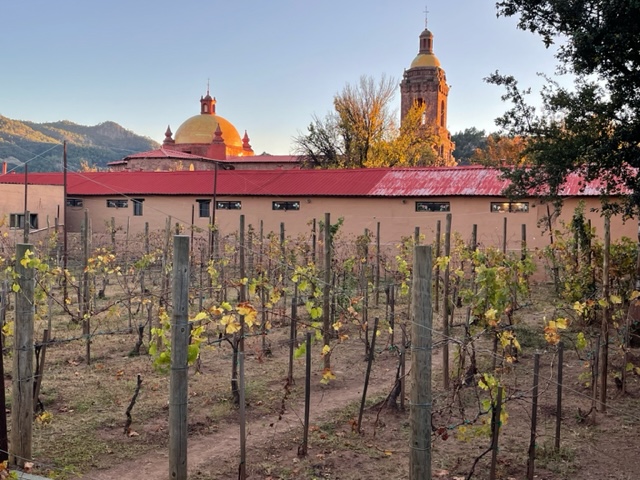
After another satisfying buffet breakfast, the hotel’s van took us to our first of many stops to a canyon overlook; this one being the deepest one, Mirador Cerro del Gallego (Galician Hill); providing what would be the most spectacular and expansive canyon view of all. Getting there was half the fun ~ the road was narrow and bumpy with sheer drops to one side. David kept his vision straight ahead as we climbed to almost 8,000 feet above sea level!


Once there, it was a short walk across a slightly swaying open caged metal bridge spanning a chasm (here, too, David kept his tunnel vision alert). It took us to the lookout; there you can look far and wide and below to the tiny, isolated riverfront town of Urique, with a population of just over a thousand. I wondered how long it would take to drive the switchbacks down there (and back!).


That night, with temps dipping down into the low 40s, we retreated to our attractively decorated, Mexican décor hotel room heated by a wood stove. I had to recruit the help of an Eagle Scout to light up ours. What do two city boys know about lighting a fire?! We’d have frozen to death if not for John’s expertise. The room glowed with a cozy warmth + clean mountain air = great sleep!

The Hotel Mirador at Divisidero was our next stop for the next two “sleeps.” Every room here faces the canyon wall and offers the most picture perfect postcard views, as it sits on the rims of the Canyons of Urique, Tararacua and Cobre at an altitude of 7,347 feet!
As we approached the entrance to the hotel, a group of Taramahura ladies were displaying their handcrafted wares all spread out to admire. One was weaving an intricate basket that David instantly fell in love with, and purchased it soon after she finished weaving it. She kindly consented to a photo, too. Of course, she looked askance, as not to have her direct image “captured;” preserving the window to her soul.


A Room With a View to Die For. The room’s balcony offers an astounding, not to be believed view. Watching the canyon walls change color as the sunlight worked its magic from sunrise to sunset was a show in itself. Frolicking below in the trees were a pair of Acorn Woodpeckers topped with their red hats. Shown here, Dandy David models his outfit that somehow matches nature’s colors.






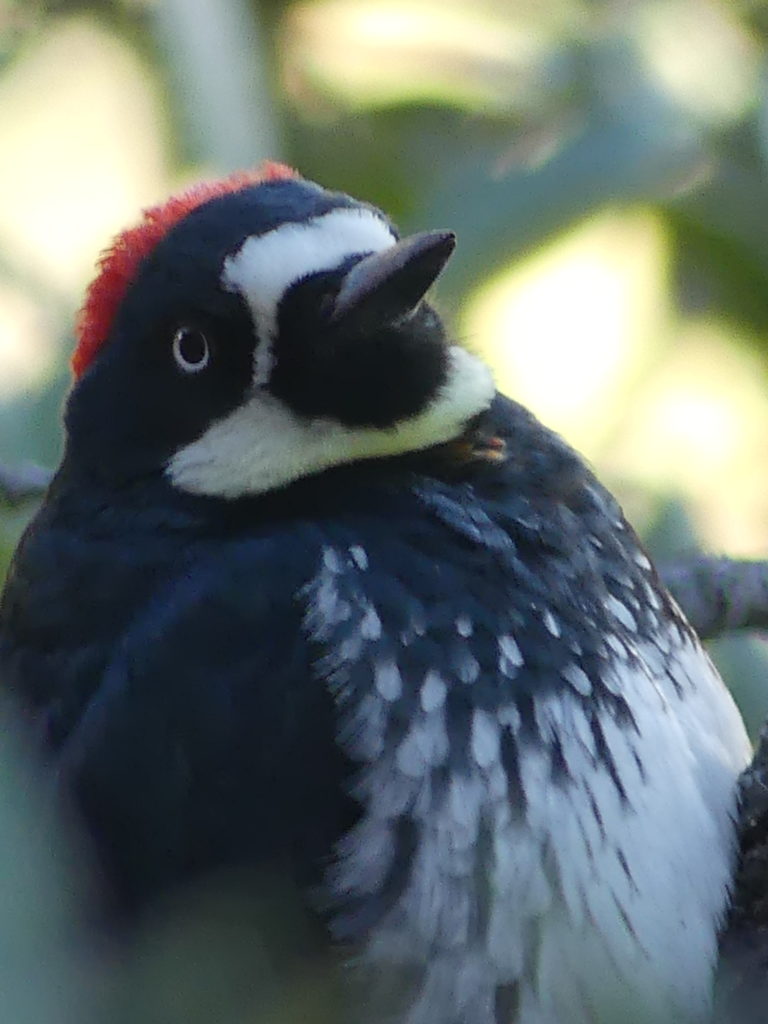
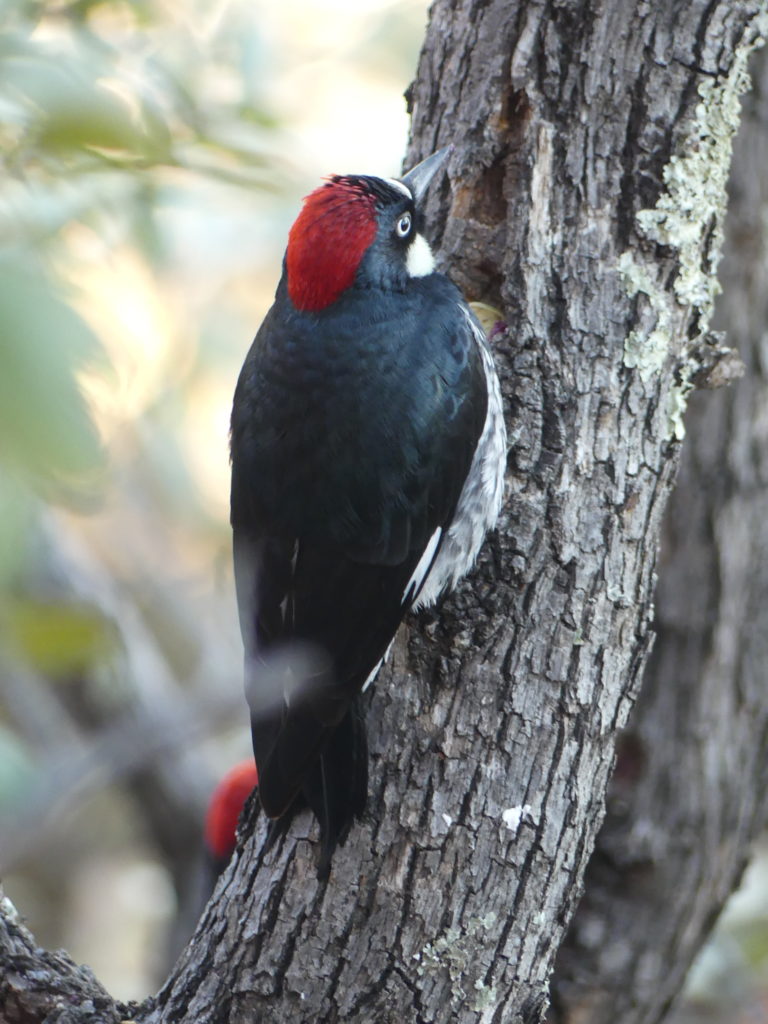

A chilly morning’s visit included a tour of the nearby Divisadero Overlook and Adventure Park. We were informed prior to our trip that all the attractions were closed due to maintenance. The park has the third longest cable car ride in the world as it traverses the valley below; it also has zip lining, rock climbing, and an aerial forest. A portion of the restaurant’s floor is glass, as the building is suspended over the rim of the canyon. Hot chocolates were in order.



Lookouts were here, there, everywhere; between these miradors, we had the option of a 30-minute walk along the rim of the canyon, on a trail that meandered close to the edge, and then back into a thick pine forest. The fresh, crisp mountain air was cleansing and should be bottled.

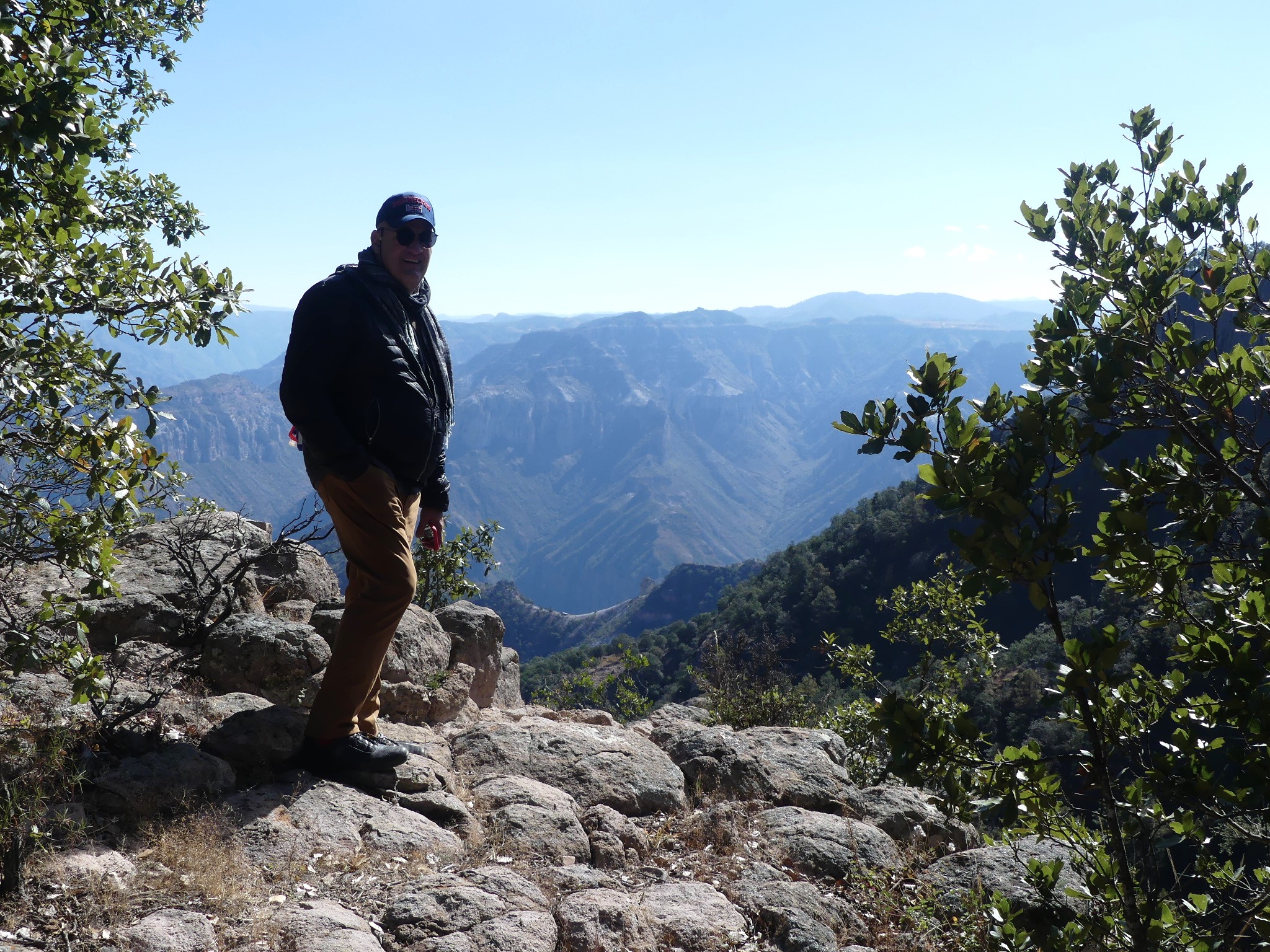

Meals throughout this trip were all included, served prix-fixe: soup, an entrée, dessert; none of which rates mentioning, but when considering the remoteness of the locations, having a 30-item menu doesn’t make economic sense. Breakfasts, however, were very satisfying buffets. On this trip, food porn pix were replaced by delicious landscape wonders.
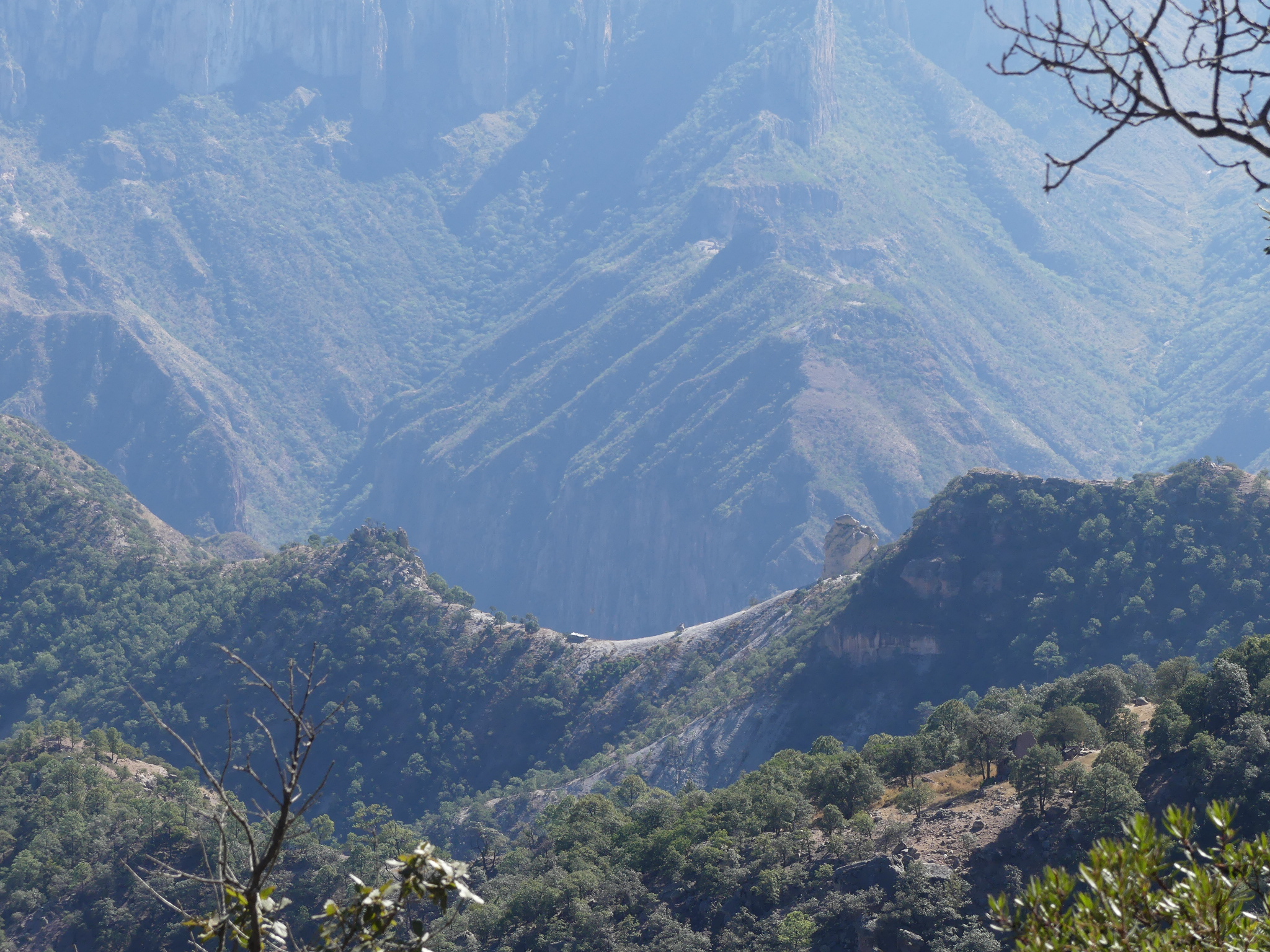
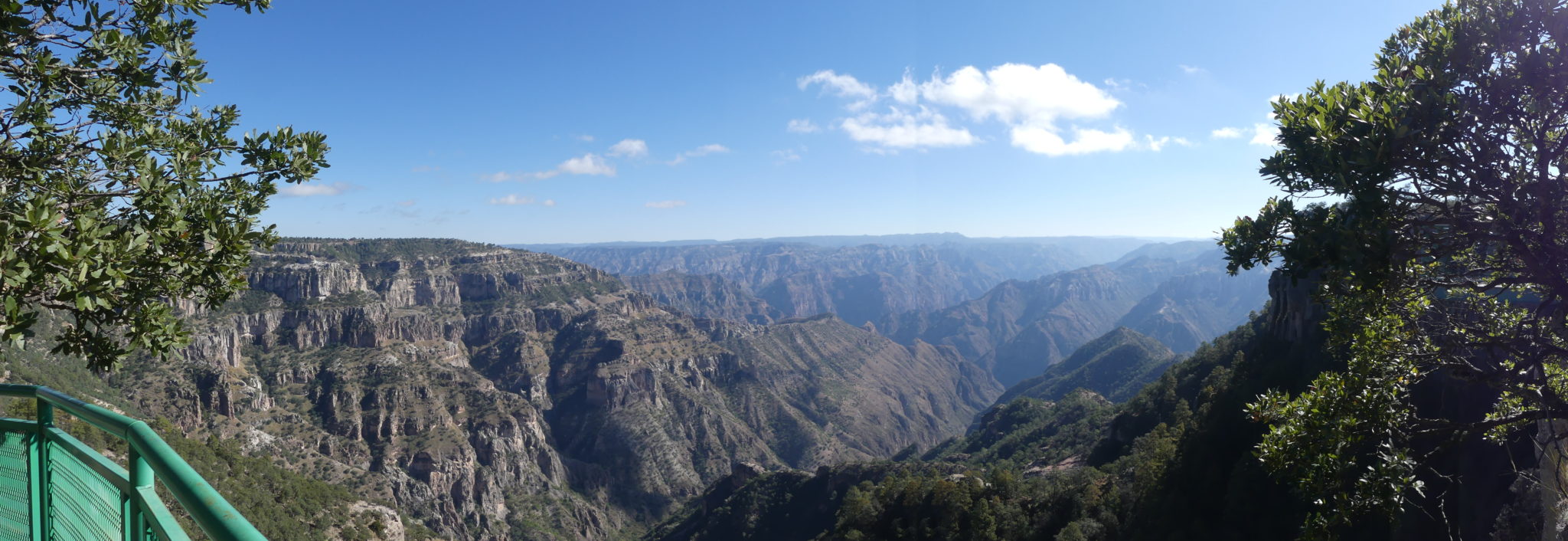
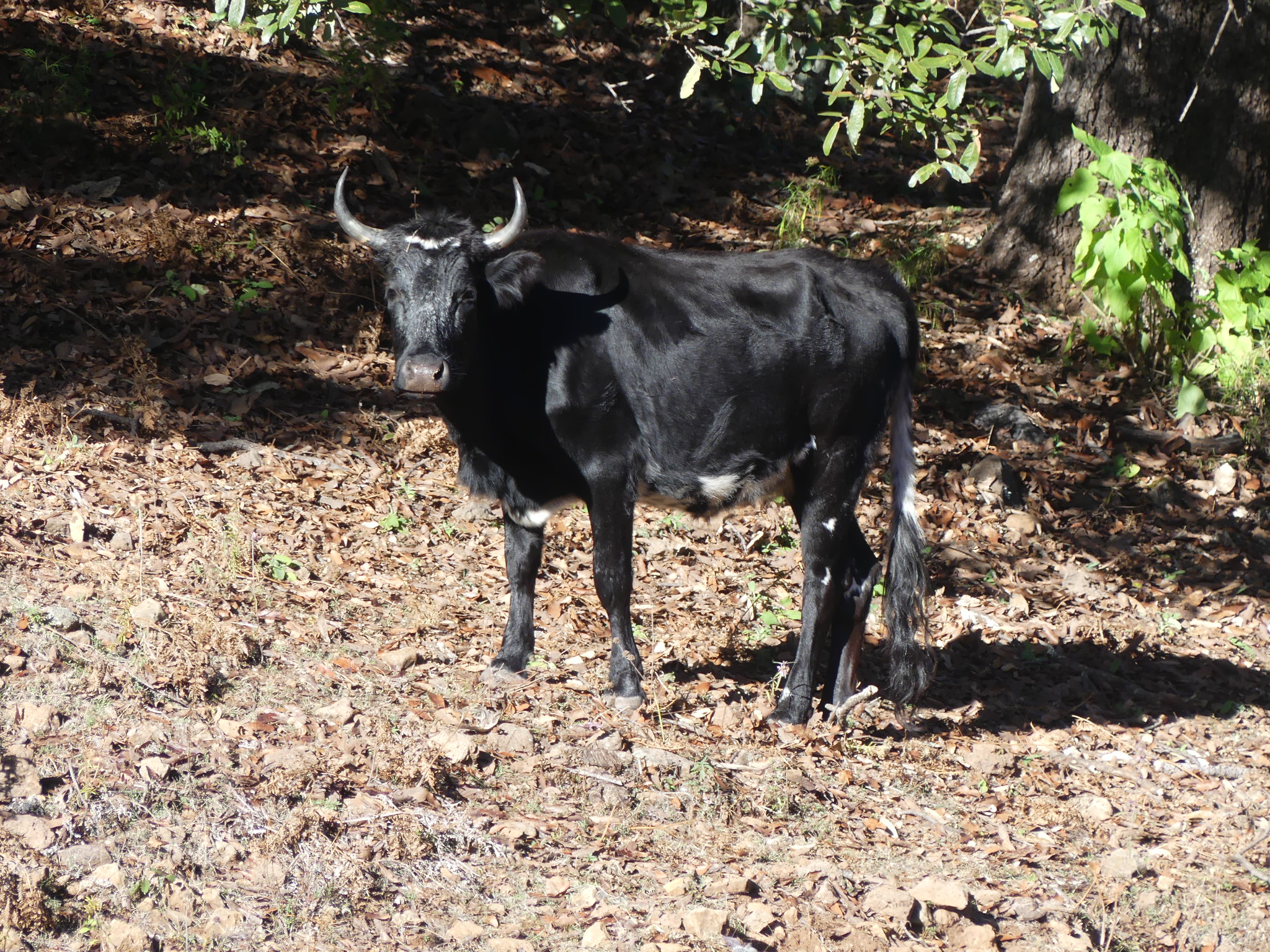
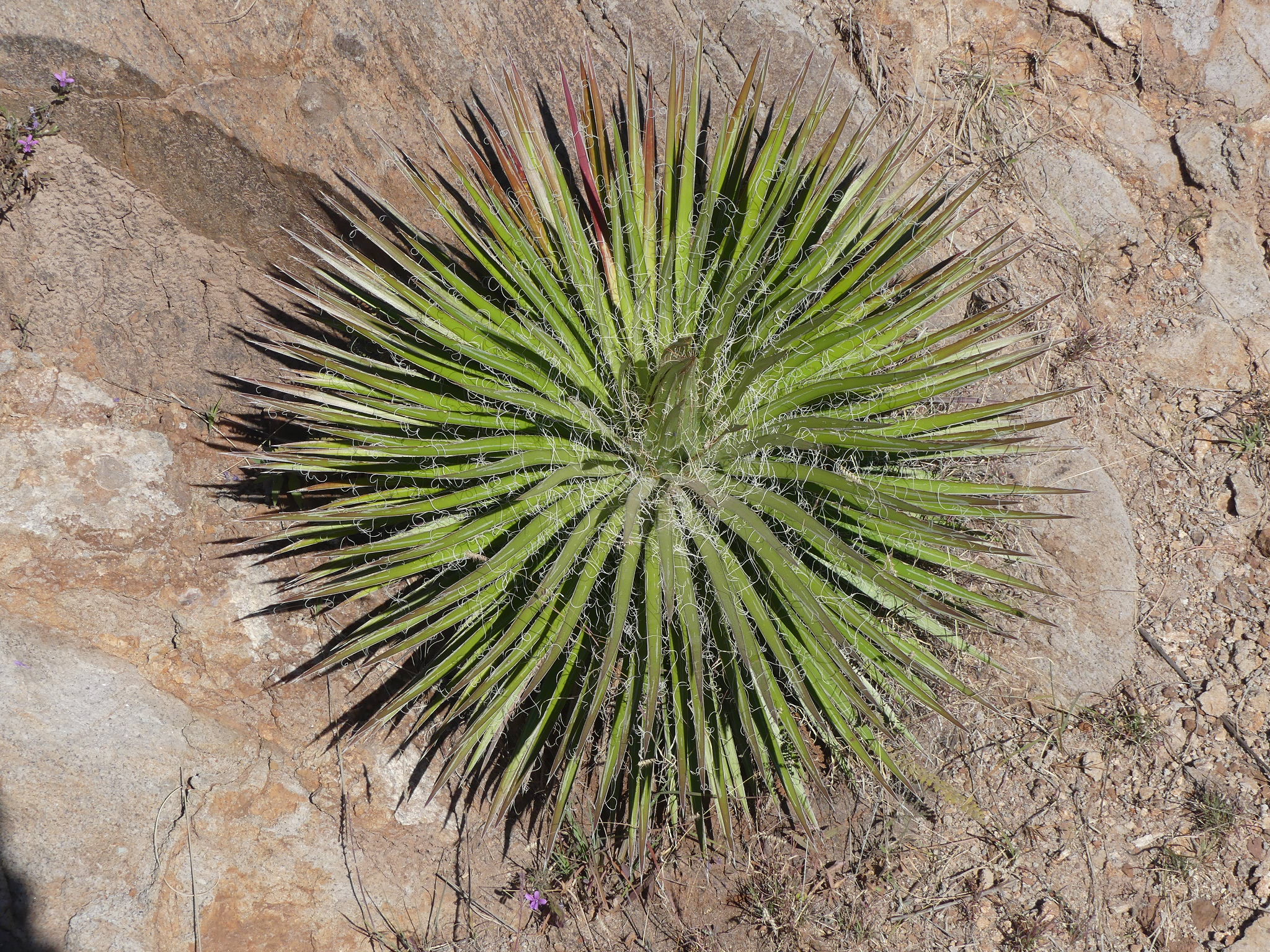

Creel, another wonderful Pueblo Mágico, and its interesting Tarahumara Museum would be our Copper Canyon grand finale. It’s filled with wonderful artifacts, and great photography depicting the story of the lives and times of these very private people. I left with a special souvenir to add to our holiday decorations: a small, opened ceramic jar featuring a Nacimiento ~ nativity scene. It now sits among my prized collection of Christmas crèches to cherish and enjoy.

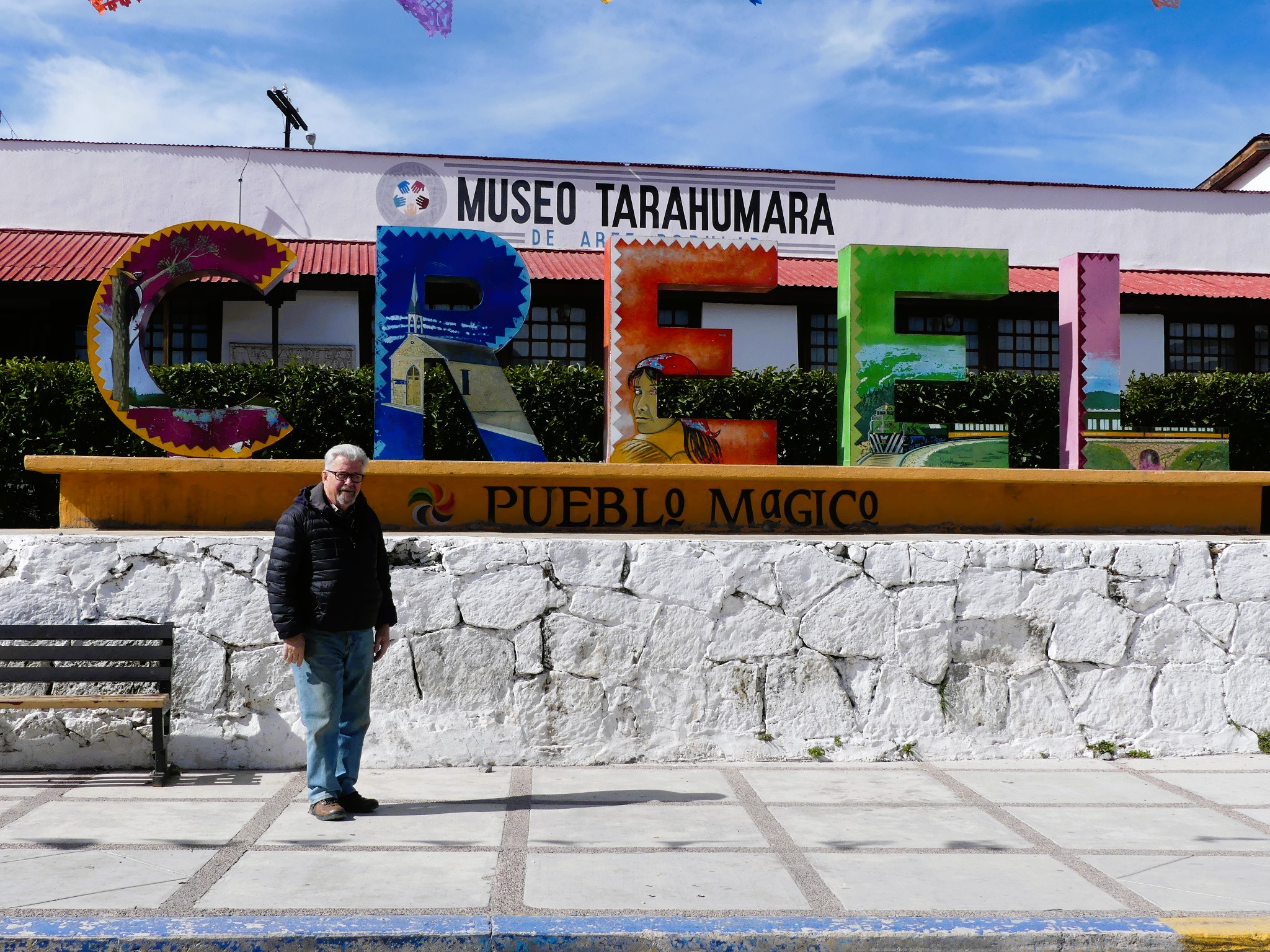






On our long drive to Chihuahua and the end-of-the-trip, we made a stop at the curious Mennonite Museum in the town of Cuauhtémoc. Mennonites migrated from Canada and this year marks their 100 years living in Mexico. Their population now exceeds 90,000 in Chihuahua State. They’ve worked hard, and have developed the once bleak, desolate area into an agricultural mecca. Here they developed the most productive region in Latin America for apples! We bought a couple of jars of their homemade fruit preserves to enjoy at home.
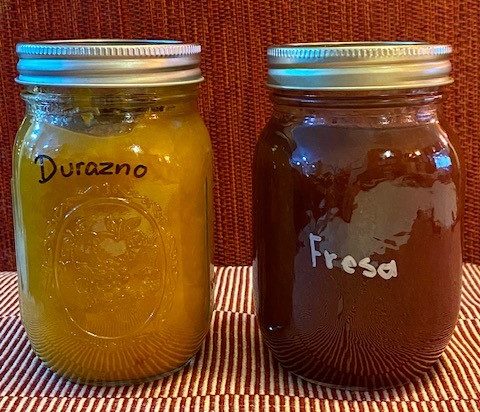
Finally reaching Chihuahua city (population: 1.1 million), where we’d stay overnight before flying home. There’s been tremendous growth happening in this capital city of Chihuahua, México’s largest state. The house of former Chihuahua governor and Mexican general during the Revolution, Pancho Villa, now turned museum, will have to wait for a future visit.

APPENDIX
A bit of information on the indigenous inhabitants of Copper Canyon, the Tarahumara or Rarámuri. With no official census, their population ranges between 35,000 and 70,000. Many reside in the cooler, mountainous regions during the sweltering summer months and migrate deeper into the canyons in the cooler winter months, where the climate is more temperate.
The Tarahumara people are known for their long-distance, endurance running; check out the fascinating, short Netflix documentary, “Lorena, Light-Footed Woman.” Living in the canyons, they travel great vertical distances, which they often do by running nonstop for hours. A popular community race is called rarajipari; played by kicking a wooden ball along the paths of the steep canyons.
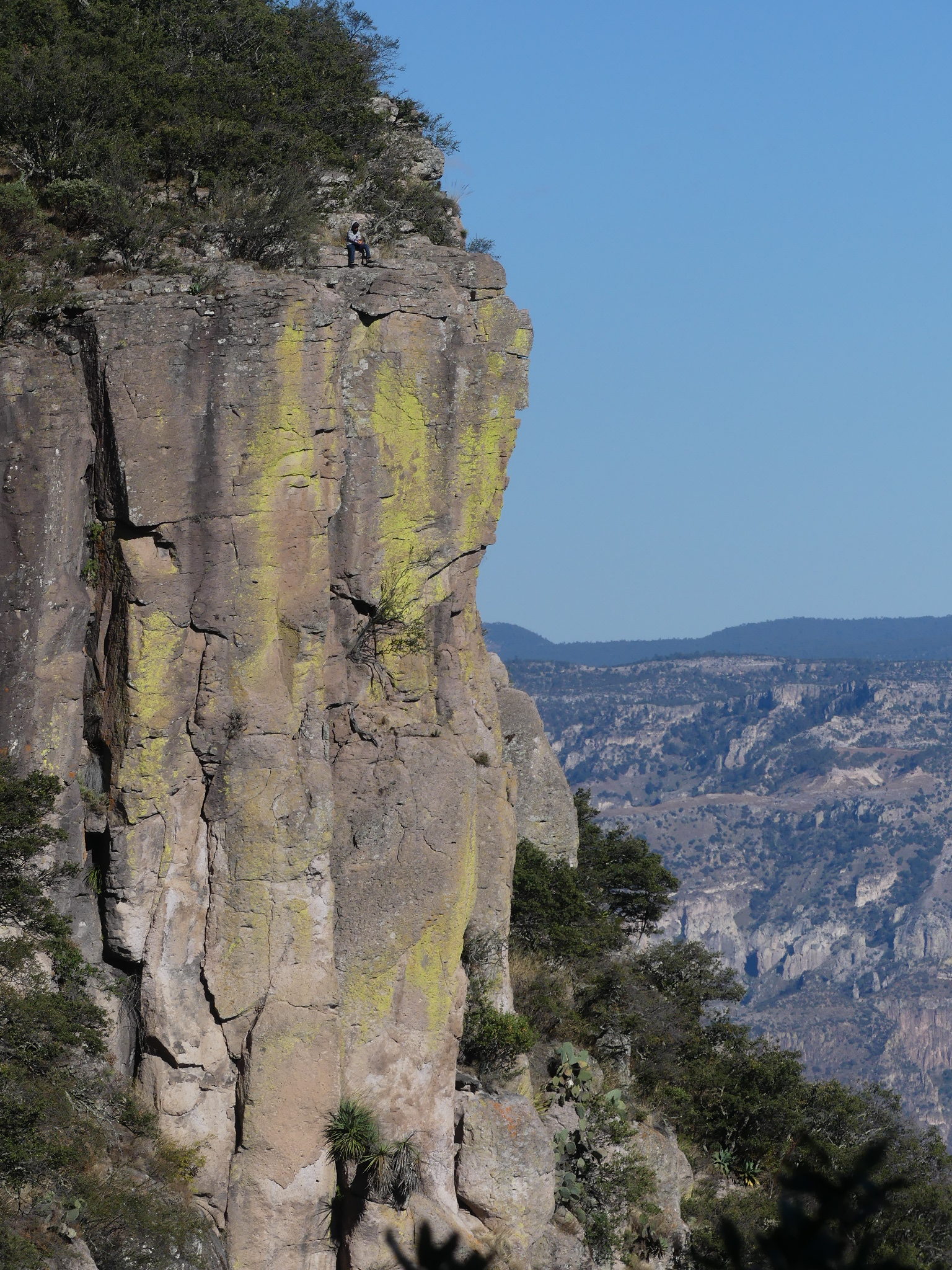
Tourism is a growing industry for Copper Canyon, but the acceptance of it is debated in the local communities. Their survival strategies have been to occupy areas that are too remote for city people, way off-the-beaten-path, in order to remain isolated and independent, avoiding losing their cultural heritage, language and traditions.
I was lucky and grateful to have shared this wonderful experience with friends that have become very dear, and my life companion. David’s a Super Trouper. He’s tagged along to the high and low places, to the wet and dry, hot and cold; bringing along his colorful and inquisitive nature. There’s a whole wide world out there that continues to enthrall and awaits.

As always, muchas gracias for tagging along for the ride!
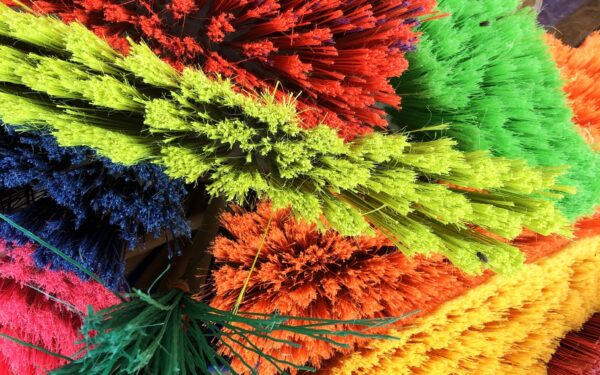

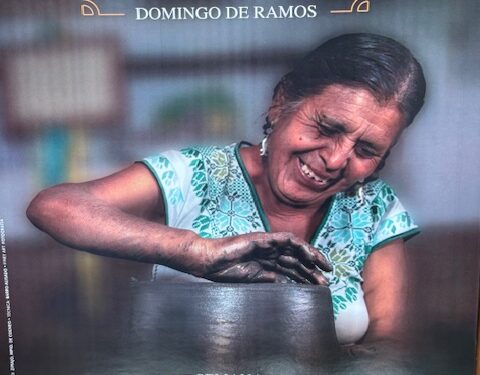

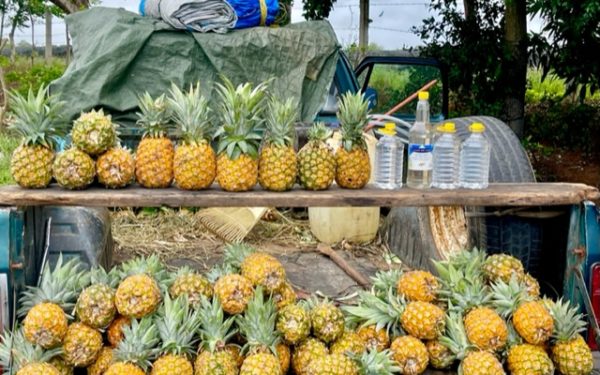
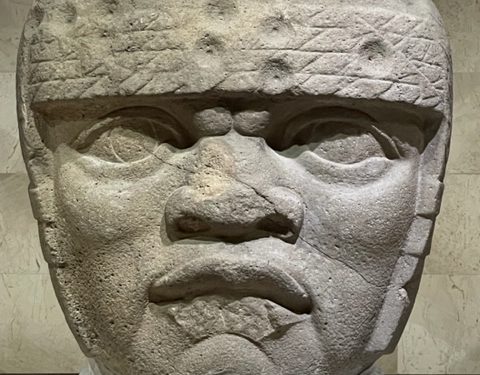
What a stunningly beautiful area. I can just see David thinking, “I will not look down, I will not look down, I will NOT look down….”
I would have had a hard time on the glass floor. It’s one thing to look down, it’s quite another to be walking on air.
I’ve been to a number of places in Mexico, but I didn’t even know about the Copper Canyon area.
I think this is the most beautiful and educational presentation I have ever seen! Thankyou so very much for sharing all this!
As always – what a ride! What made me most happy was to know that the school educated the girls in their native culture and language. That’s so important, as you mentioned, at a time when tourism and mainstream culture is reaching further and further into their territories. As usual, the pictures are absolutely stunning. I felt I was there with you.
Fantastic travelogue David, so glad you shared hour adventure.
I love mornings that linger, thoughts that wander, coffee that brings us together, and YOUR travel stories. This is a must-do trip for anyone moved by a world filled with Mexican Grace.
You captured it exactly minus the bakery “Pan de Mujeres” which our driver didn’t recommend. Must be the Sergio and David CHARM! Keep traveling, it teaches us so much.
I was there about 5 years ago, but couldn’t have put together nearly as interesting & well photographed a tale as you did! As always, thanks for taking us on your travels❣️(Loved the Pan de Mujeres 😱)
You had me at Pan de Mujeres! Once again, you’ve brought an incredible adventure to life, both with your descriptive narrative and Nat Geo worthy photos. Thank you for all the time and effort it takes to publish Musings. It’s always a joy to go along for the ride.
Thank you so much for sharing your wonderful journey. It’s great to learn about areas of Mexico that I’ve never been to. The photos are beautiful and looks like you had lot’s of tasty food on your trip. I enjoyed the vicarious thrill!!